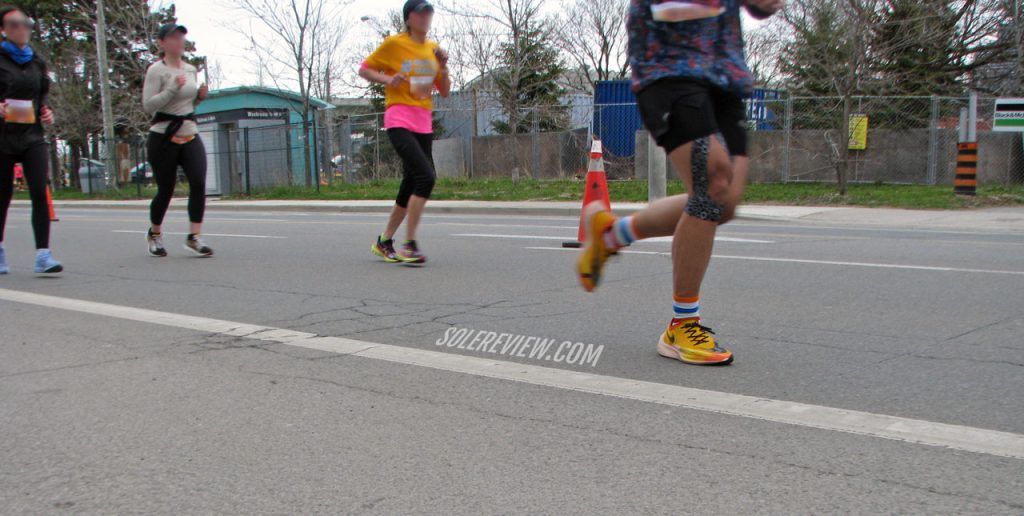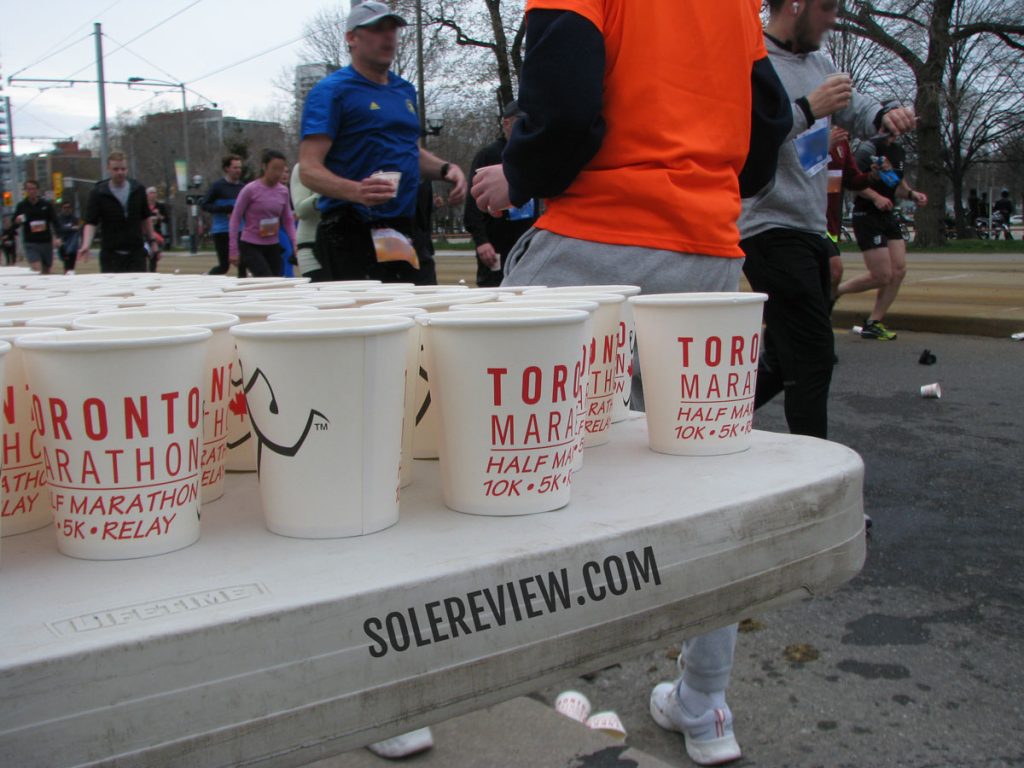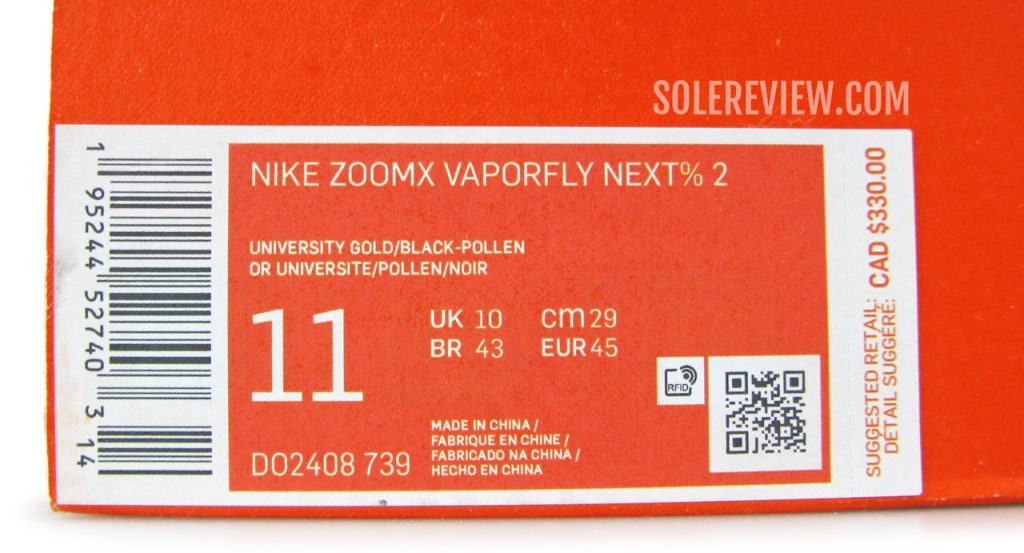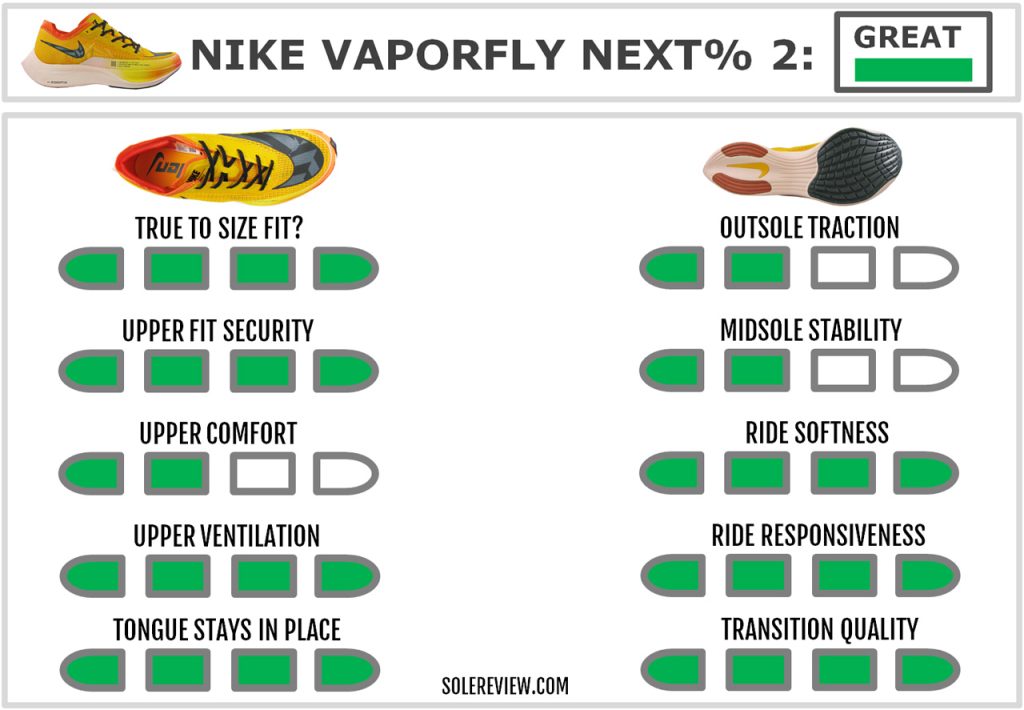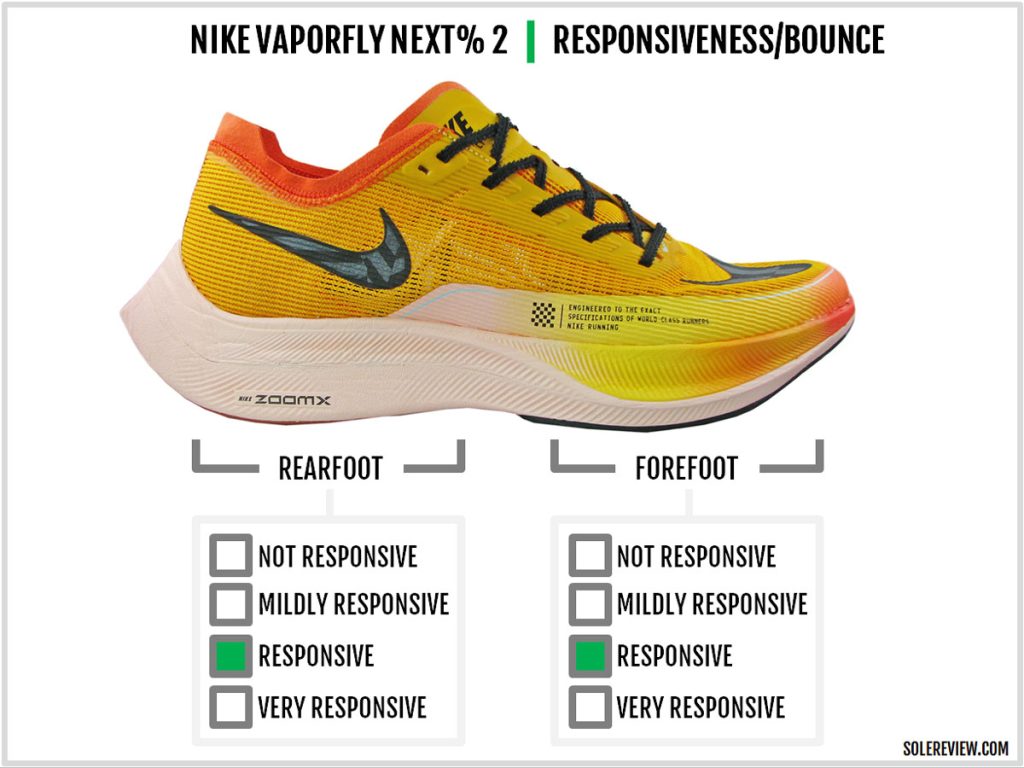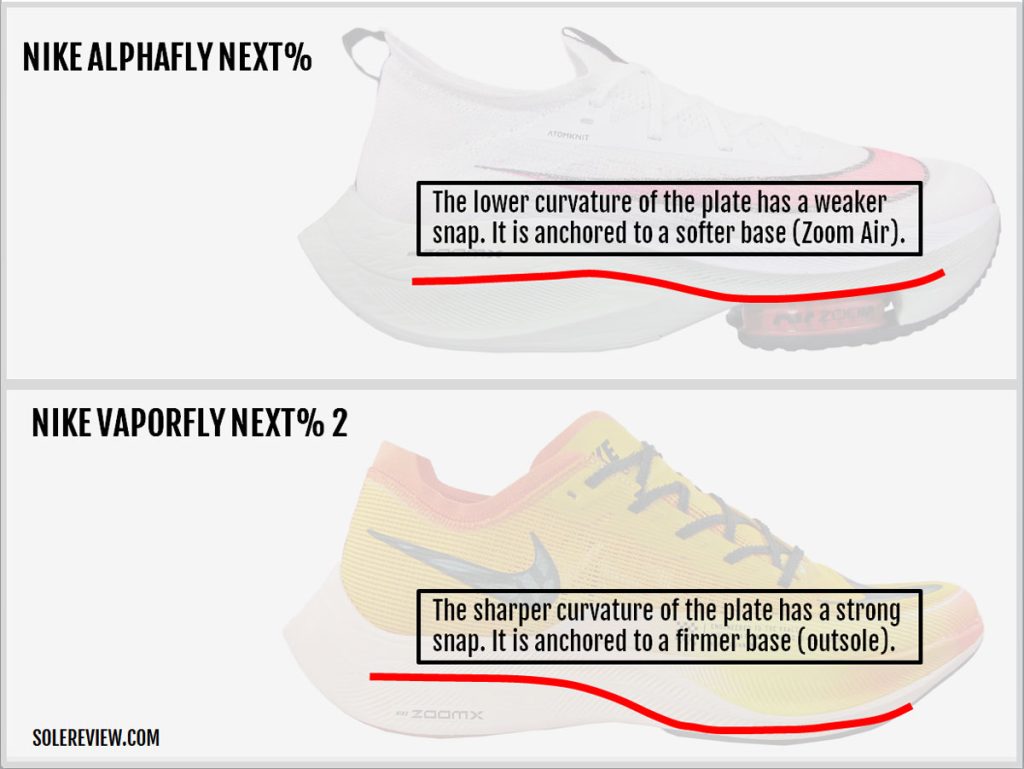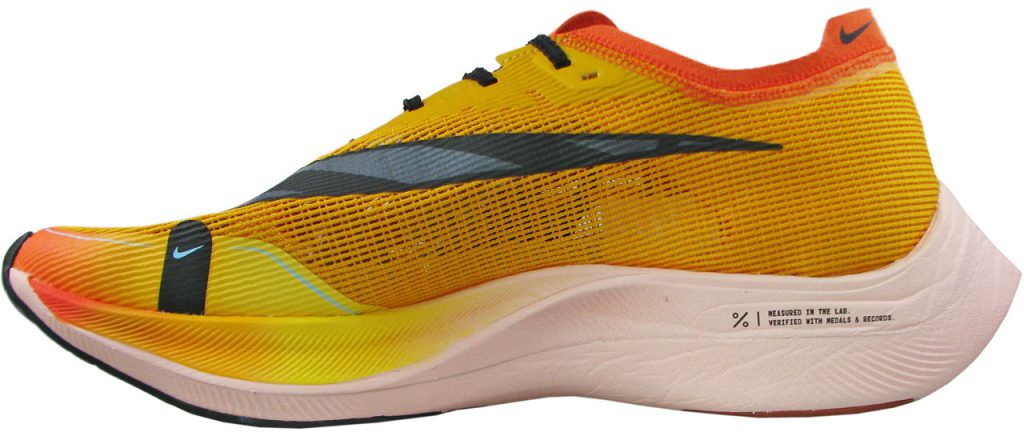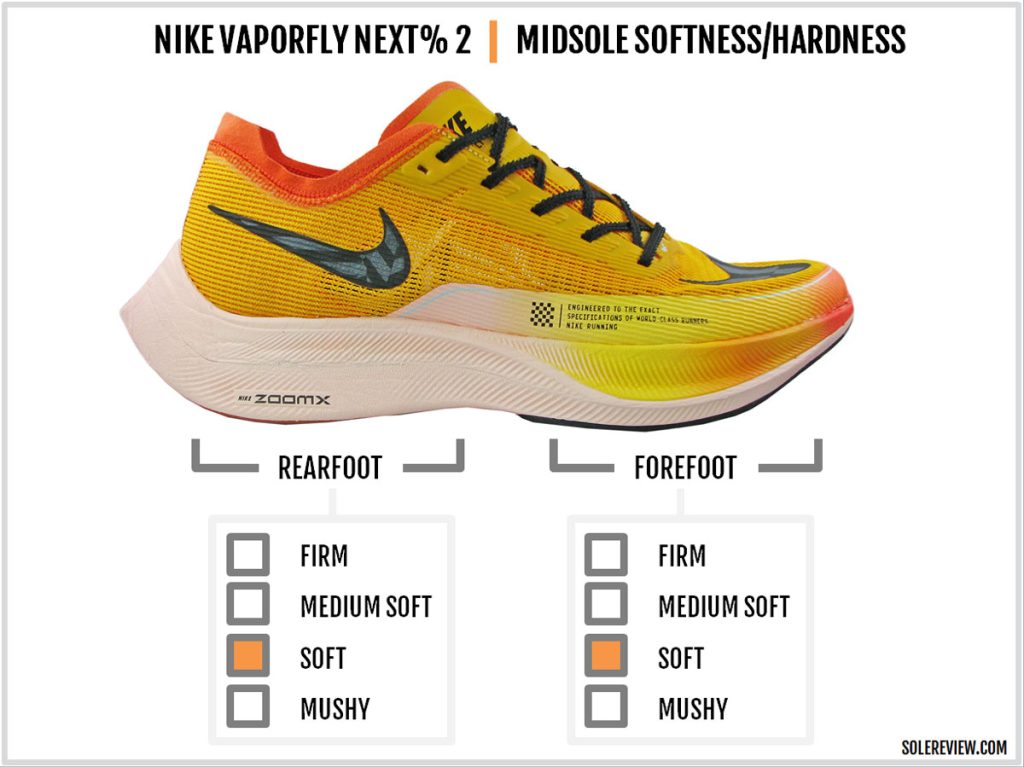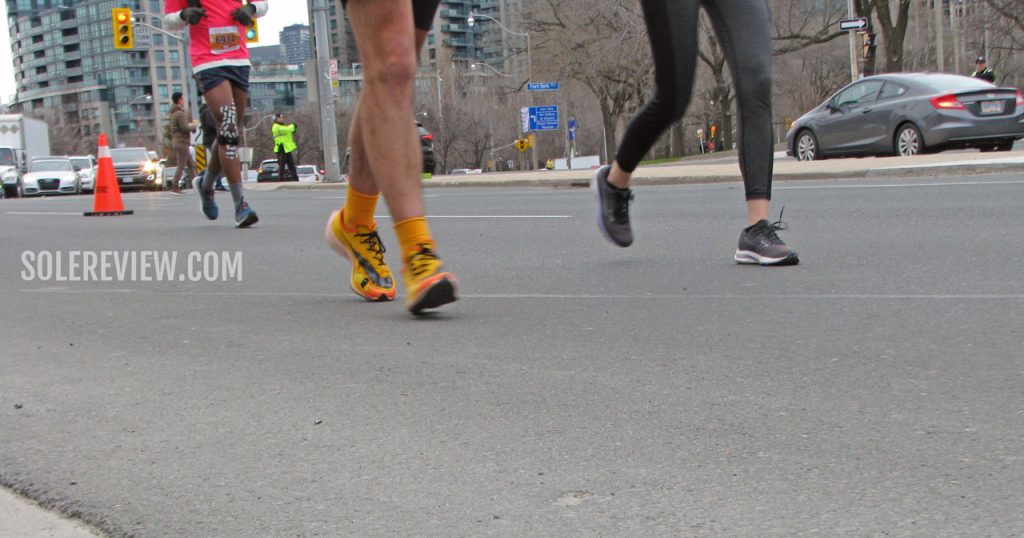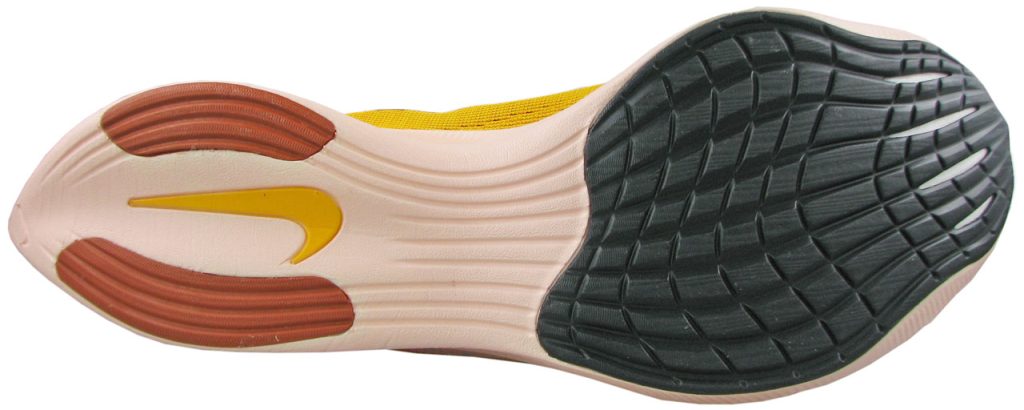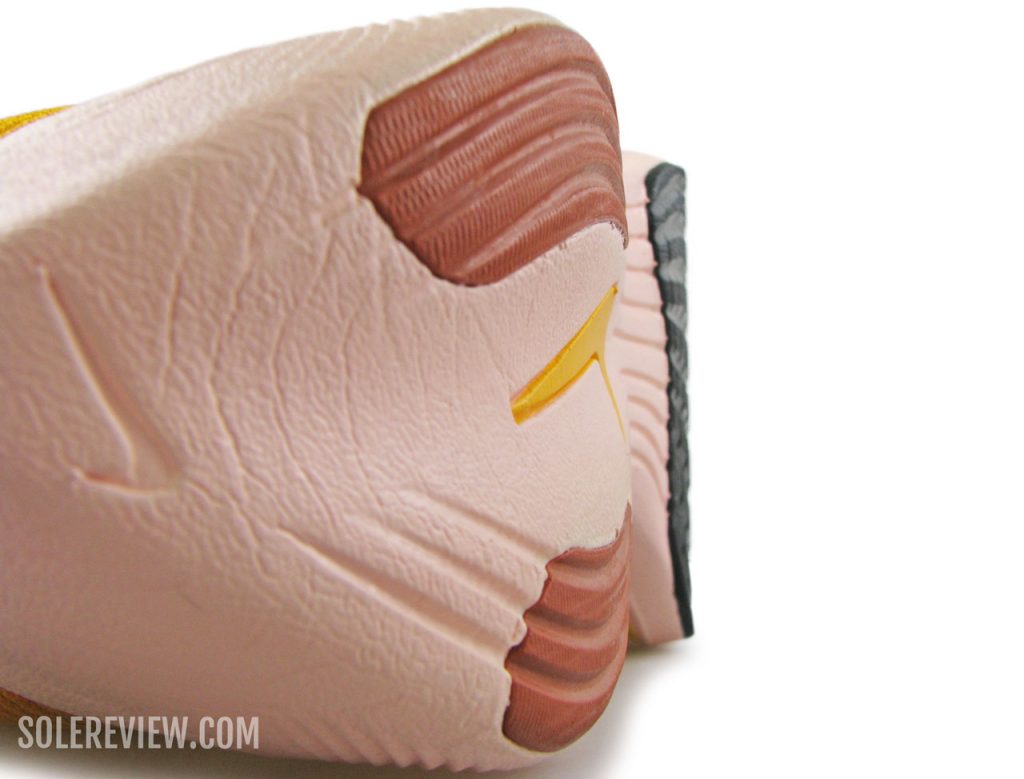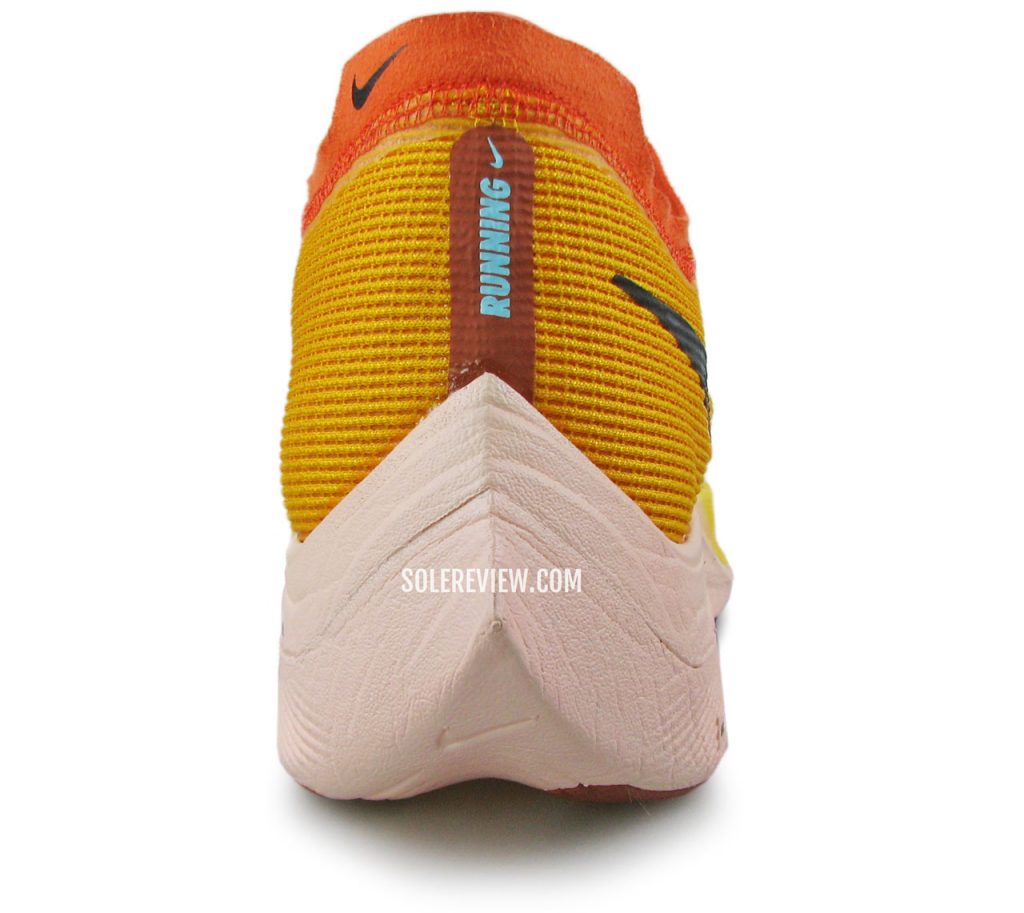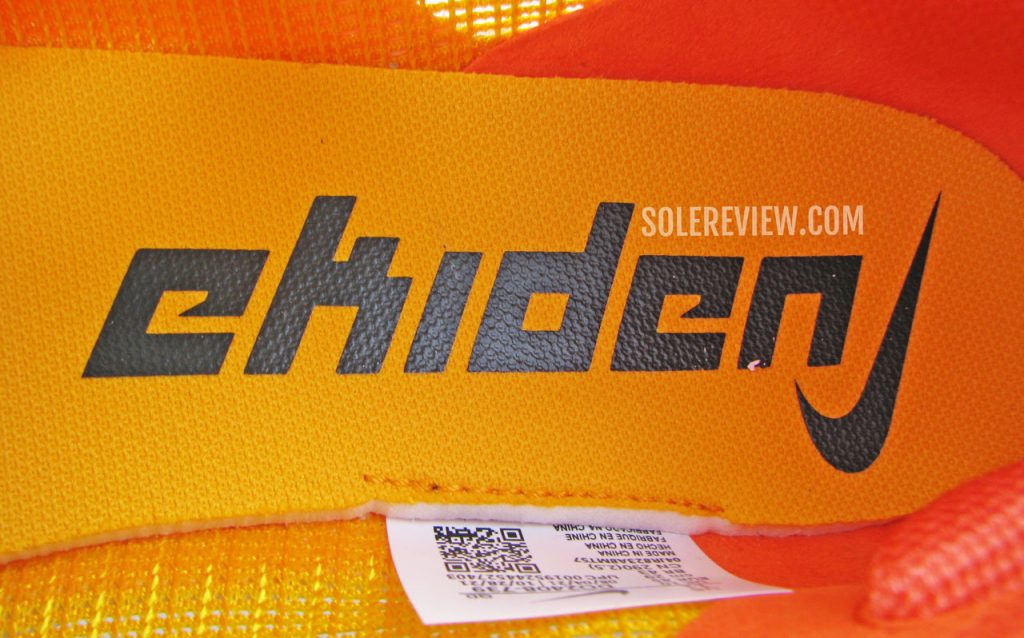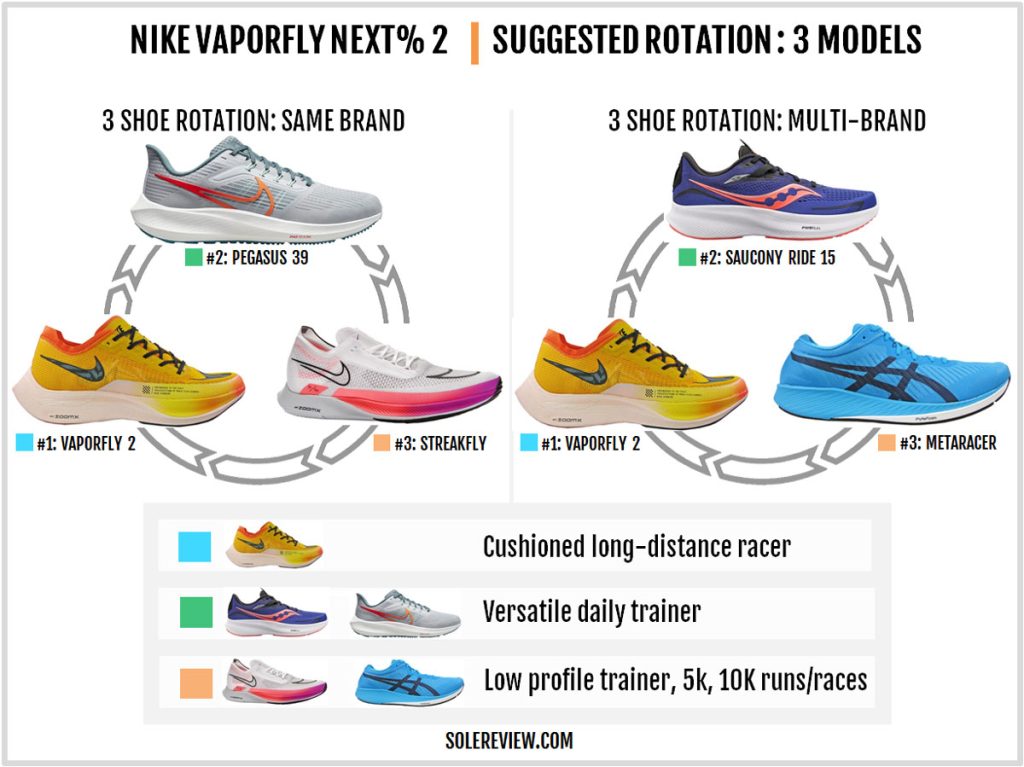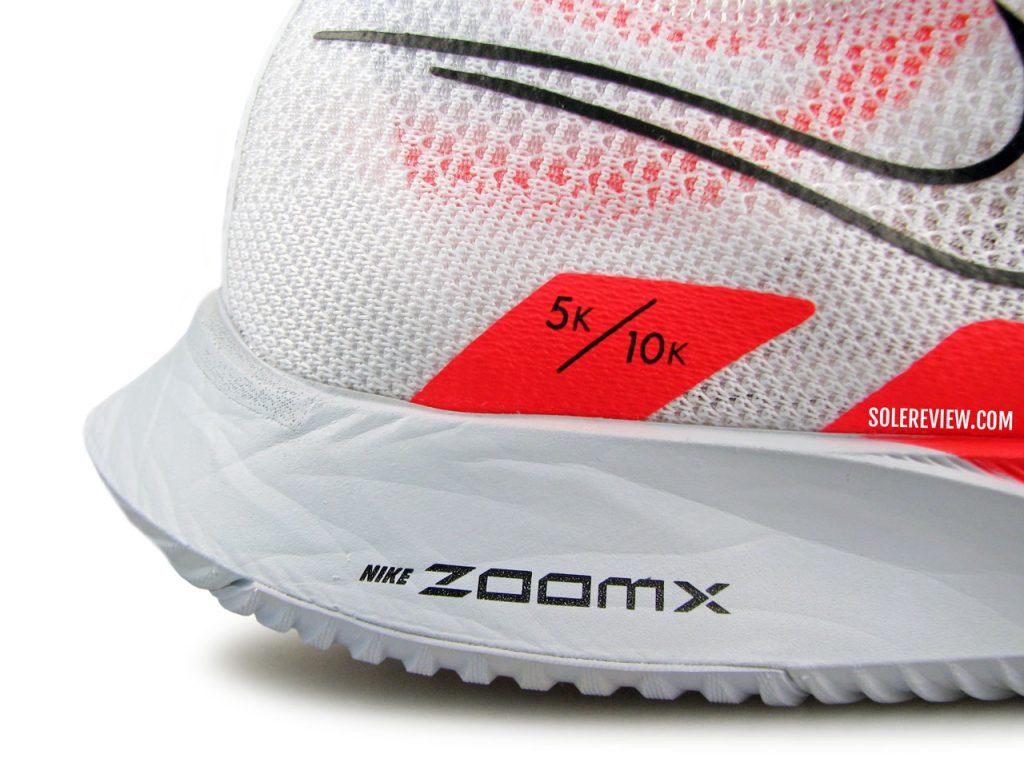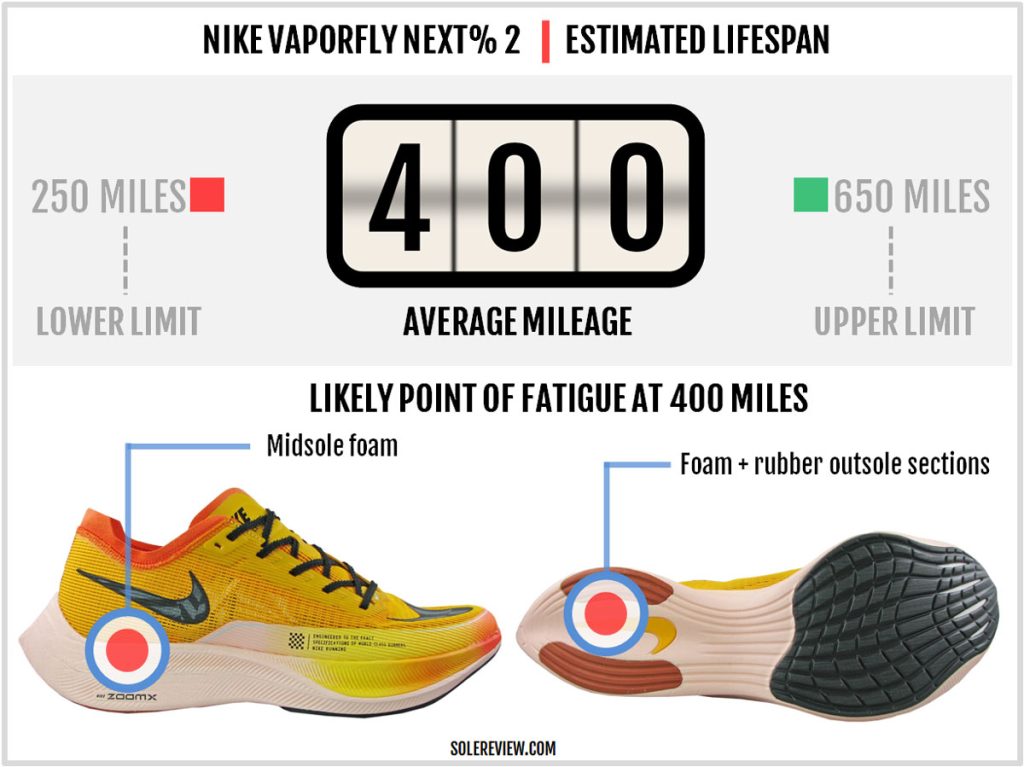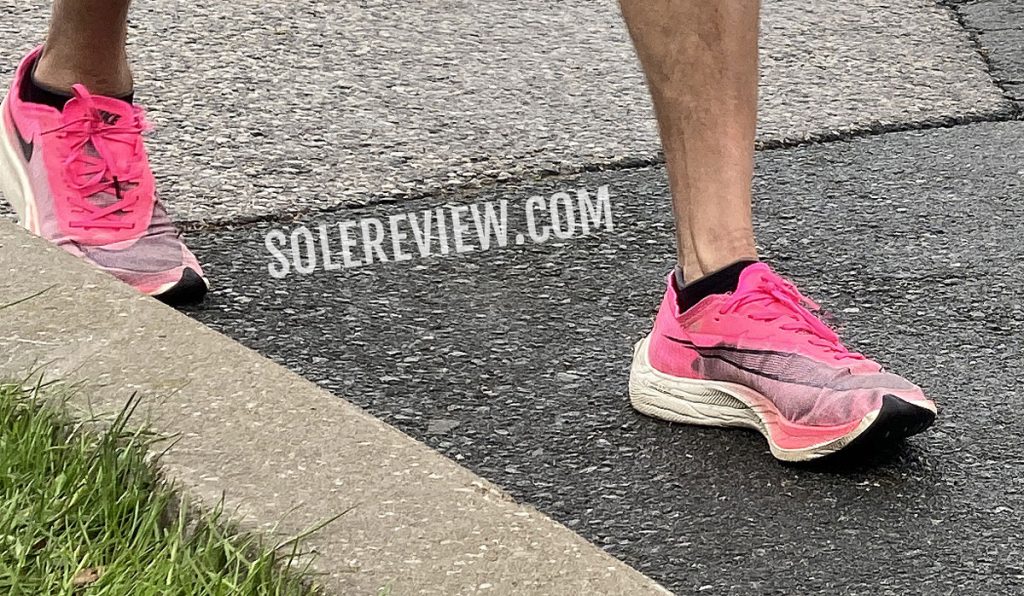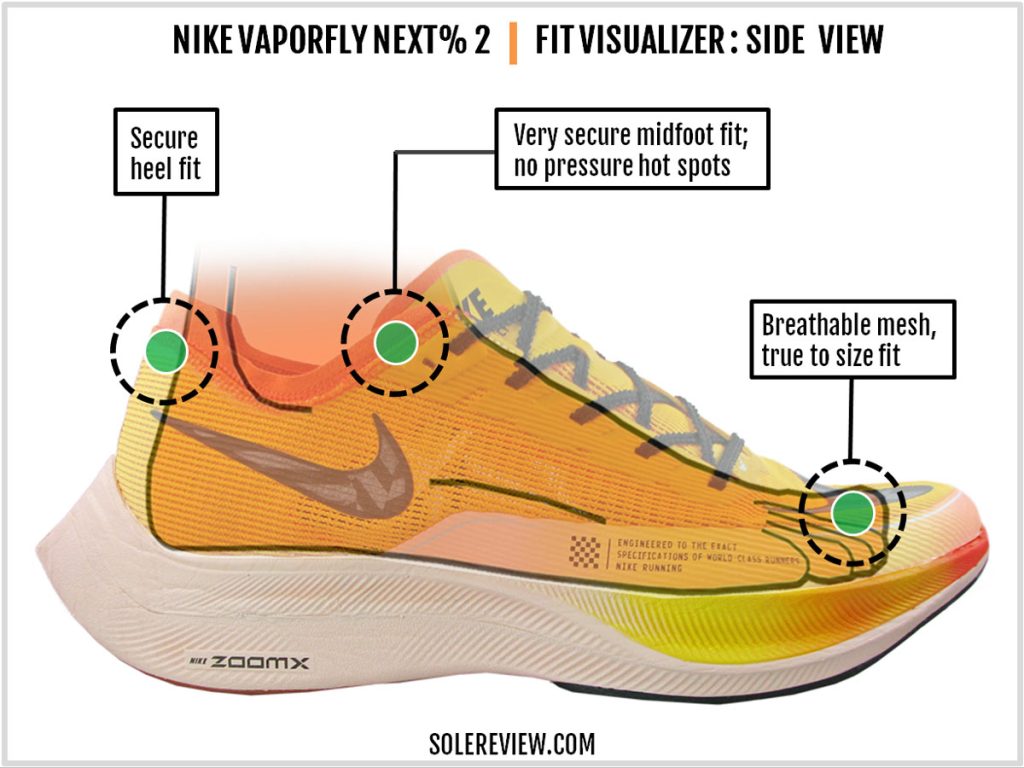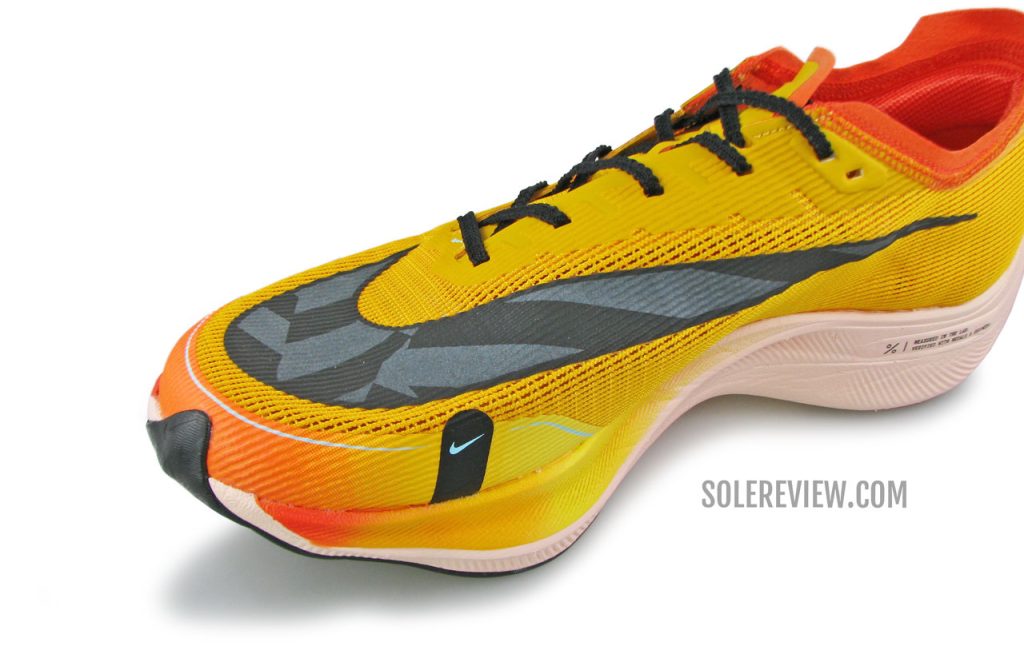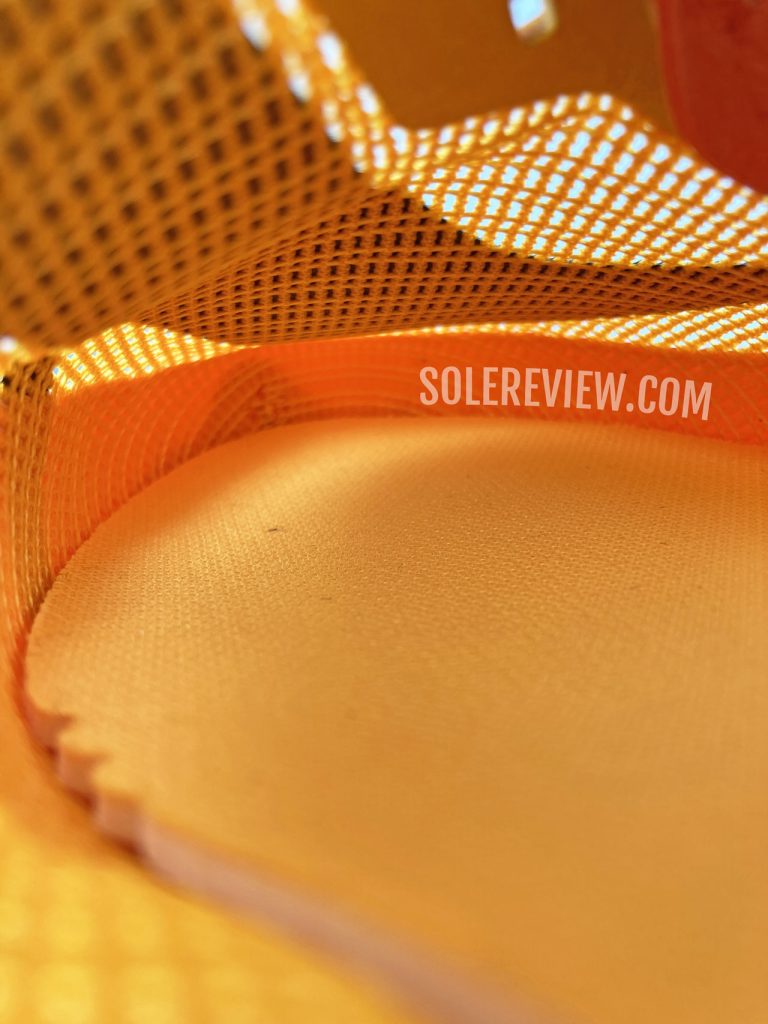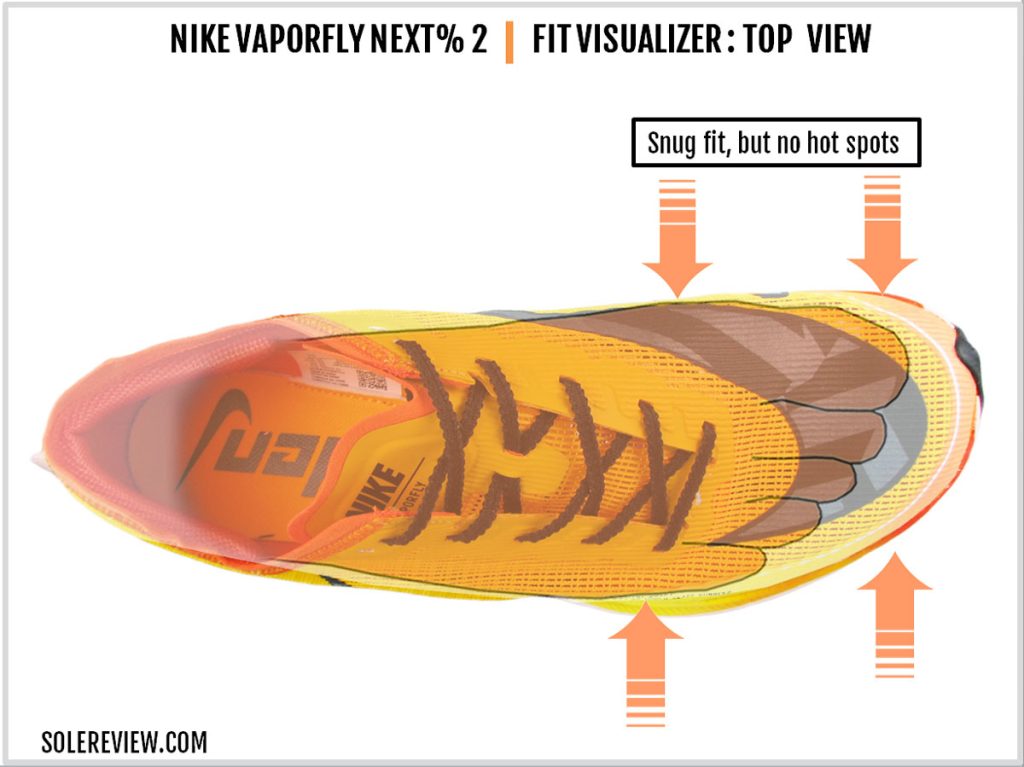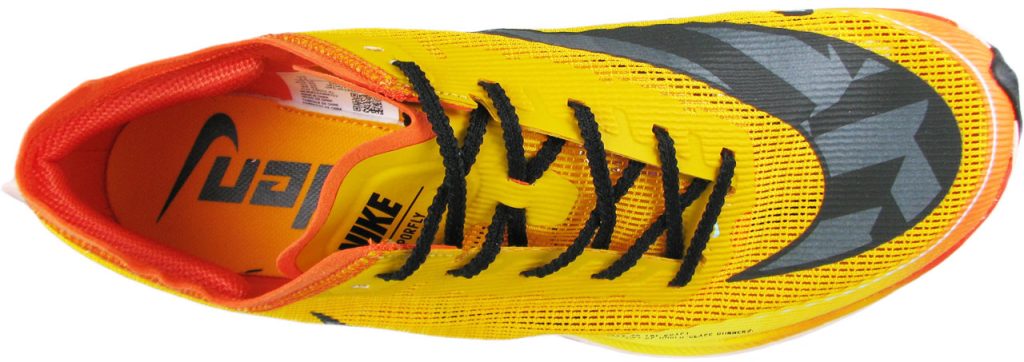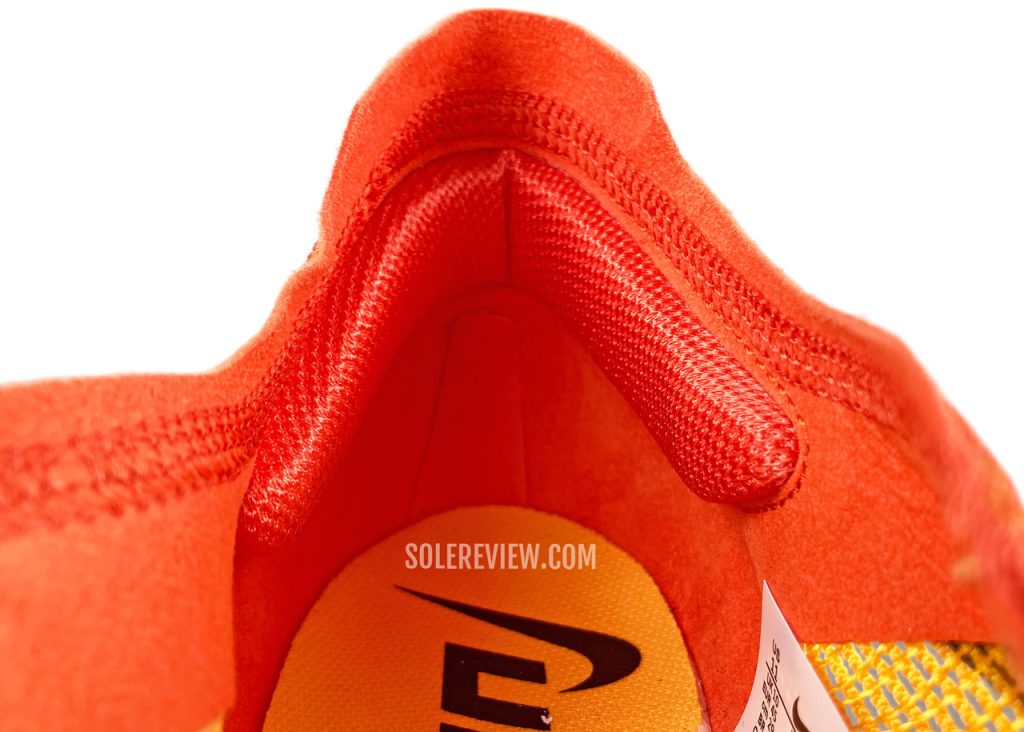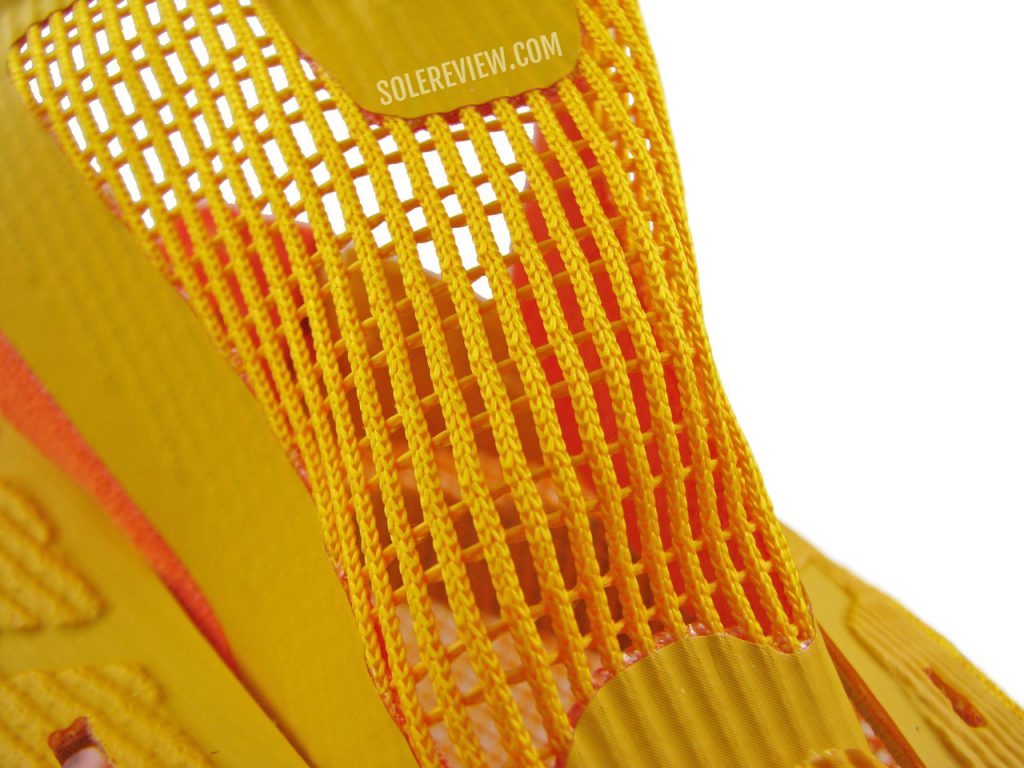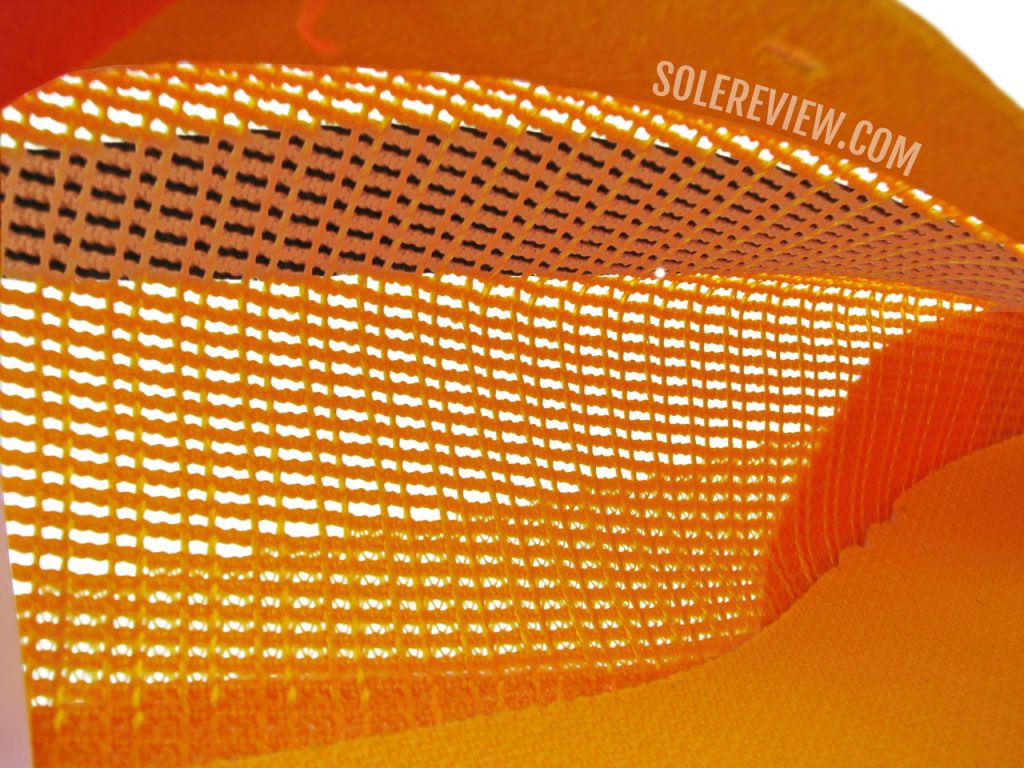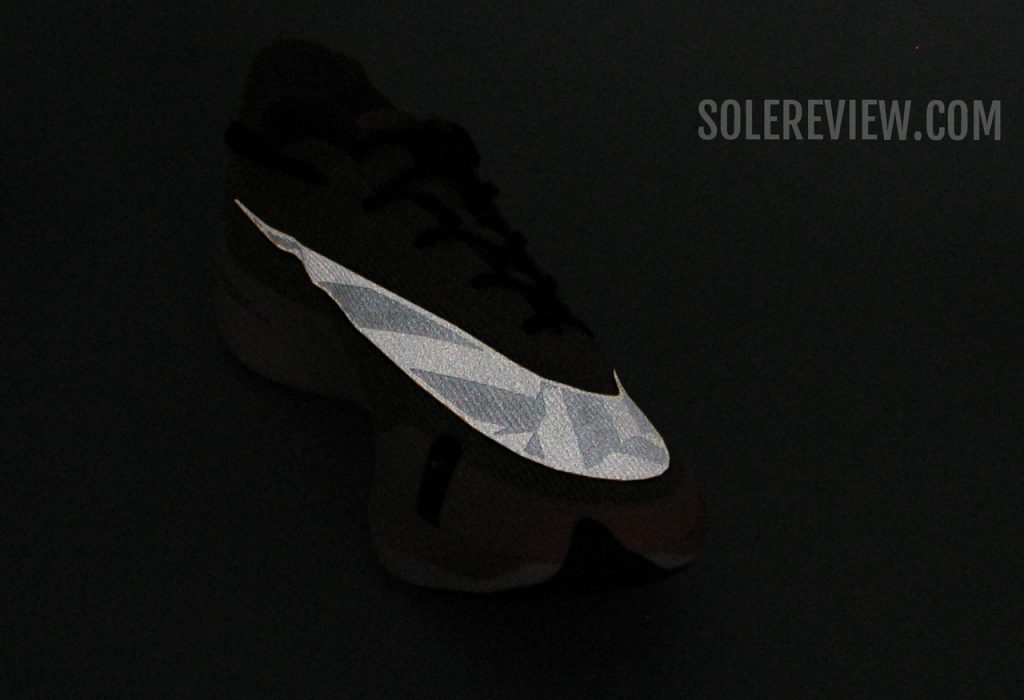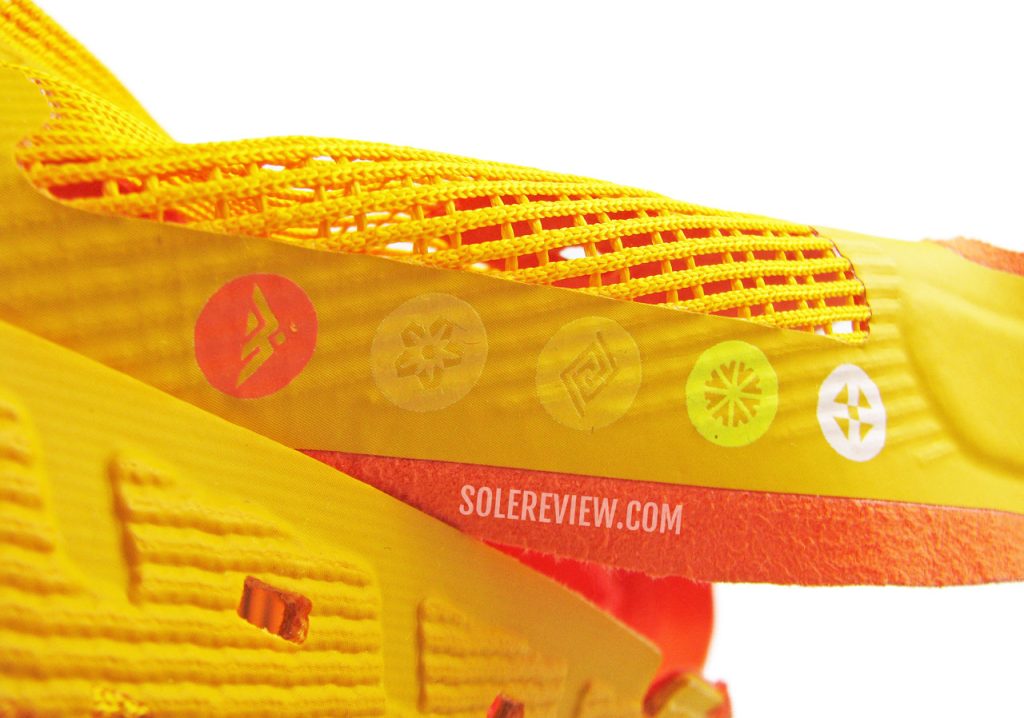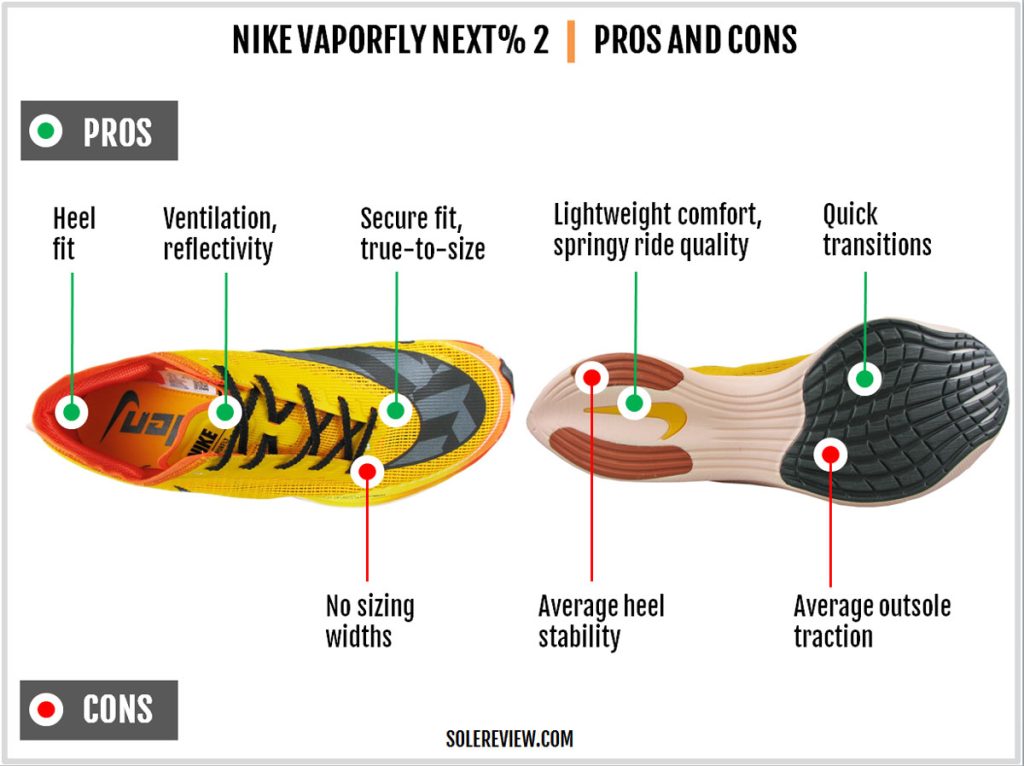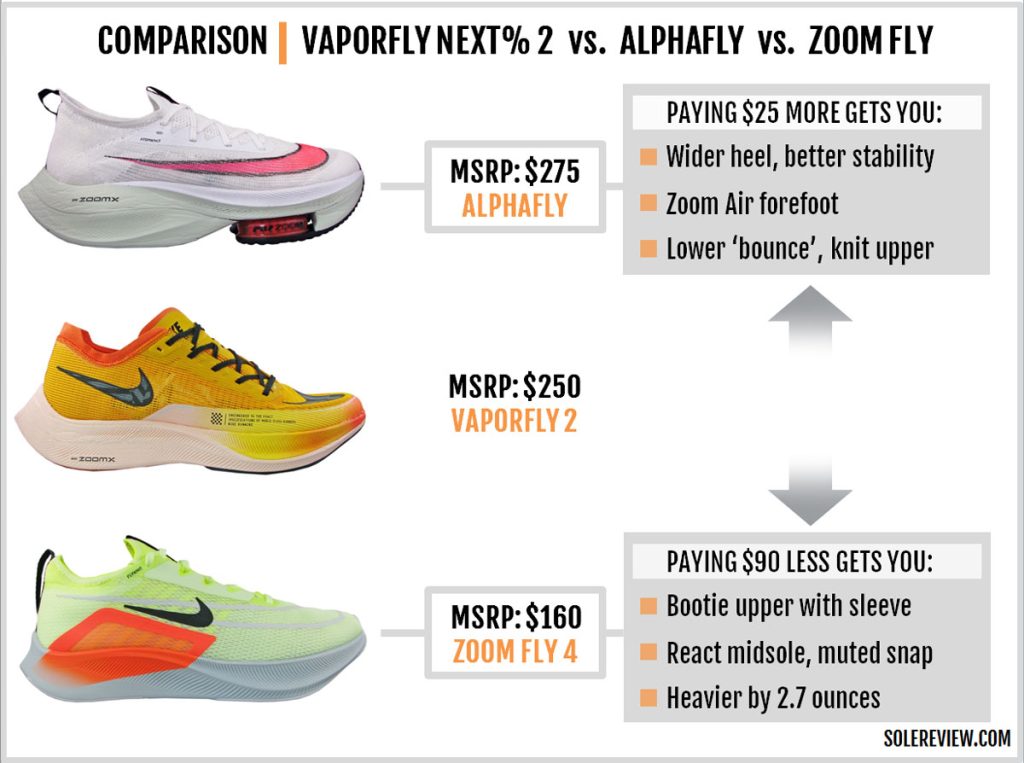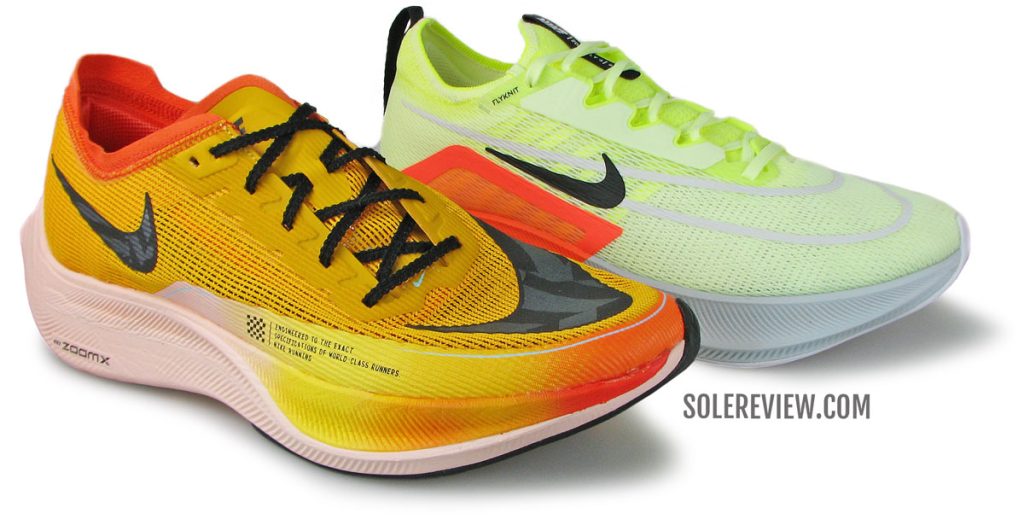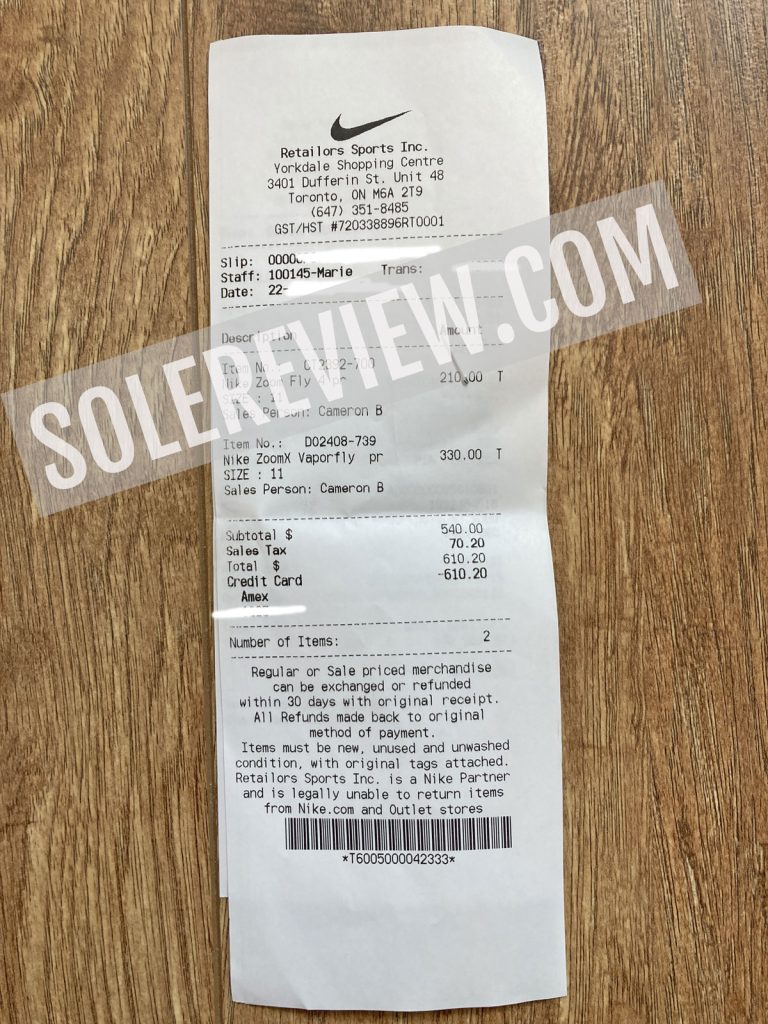
The Nike Vaporfly Next% 2 was purchased at full retail price for our review. The amount is in Canadian Dollars.
In this review:
INTRODUCTION
Not long ago, minimal racing flats were the preferred footwear for running – and winning – road races.
Before the Nike Vaporfly upended the racing shoe category, low-profile speed shoes like the adidas Boston or Nike Lunaracer were thought of as the ideal marathon shoes. Elite athletes would run in a shoe like the adidas adios or Nike Zoom Streak, whereas lesser mortals would seek comfort in the more cushioned Nike Lunaracer or Nike Lunar Tempo.
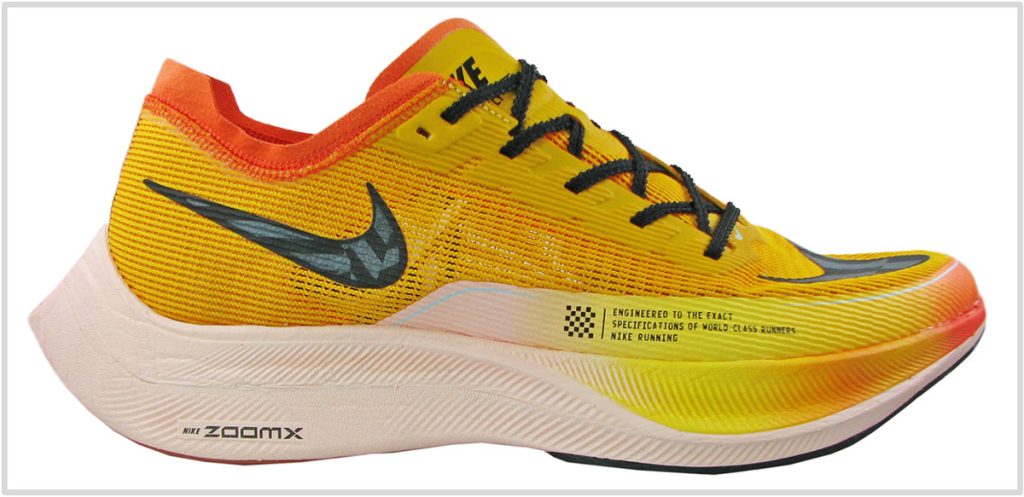
The Vaporfly was the shoe that started it all – the first mainstream racer with a cushioned ride and spring-like Carbon plate.
How times have changed.
Over the last few years, the Nike Vaporfly Next% has become the running shoe of choice for marathons and high-mileage training. It’s one thing to say this, and entirely another experience to witness it in person.
Most marathons and races were canceled for the better part of 2020 and 2021, so physical shoe counts weren’t possible. Recently, Solereview took over 300 photographs of runners (along with their shoes) who participated in the Toronto marathon.
Sure, there were many regular trainers from Asics, Brooks, Nike, and Saucony, but the Vaporfly Next% was the clear winner in the hyper-shoe category. The Saucony Endorphin Pro and Speed were a close second, with a few sightings of the New Balance RC Elite and Asics Metaspeed.
(Related read: The best running shoes for marathons.)
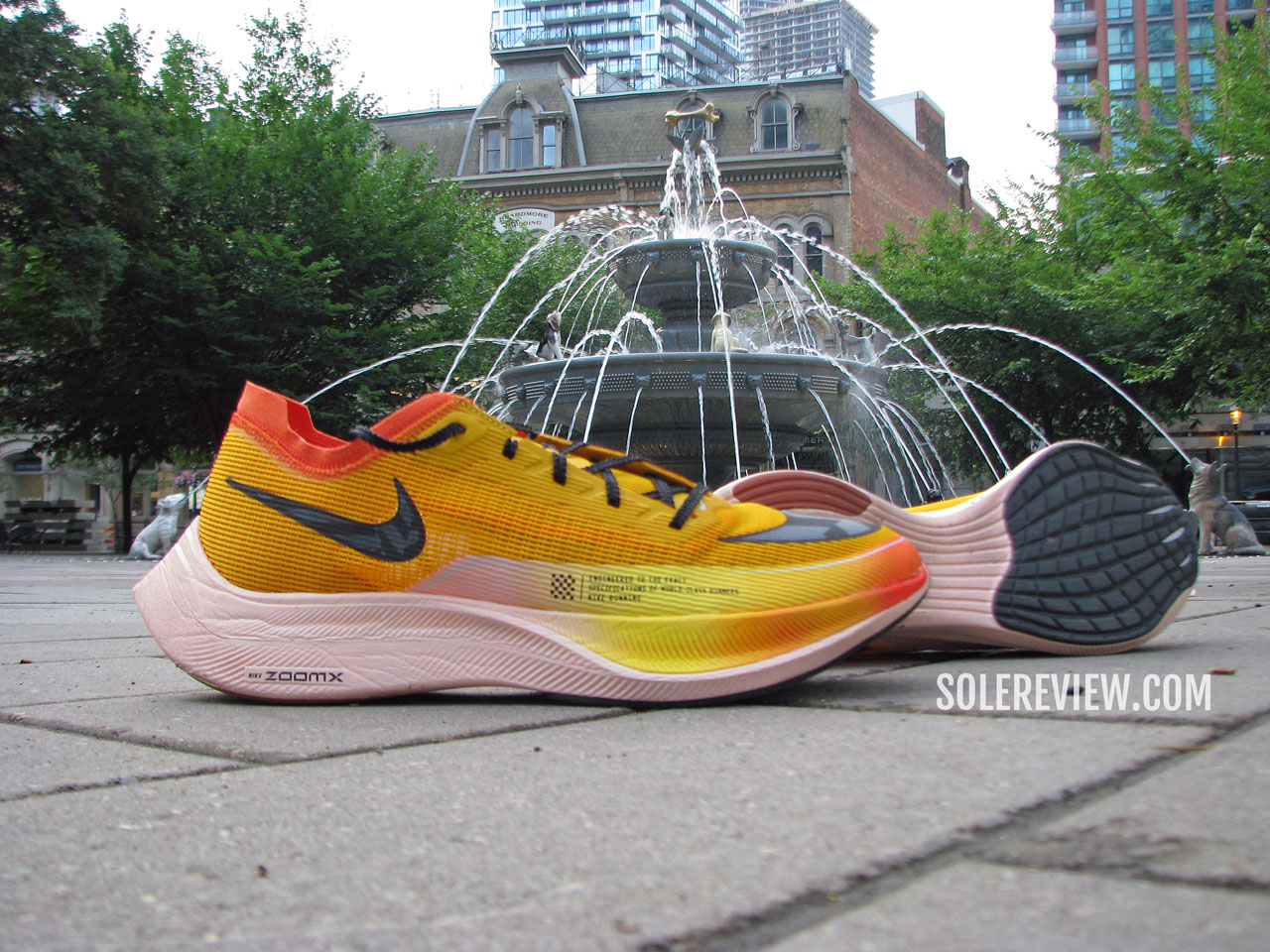
Unsurprisingly, all three shoes share a similar form factor. Nike ZoomX and Saucony Pwrrun PB are PEBA-based foams, and a full-length plate inside the midsole creates the signature spring-like effect.
By the way, PEBA is a shortened form of PolyEtherBlockAmide – a thermoelastic Polymer that is available in many forms, ranging from stiff plates (think football shoe cleats) to soft foams like ZoomX.
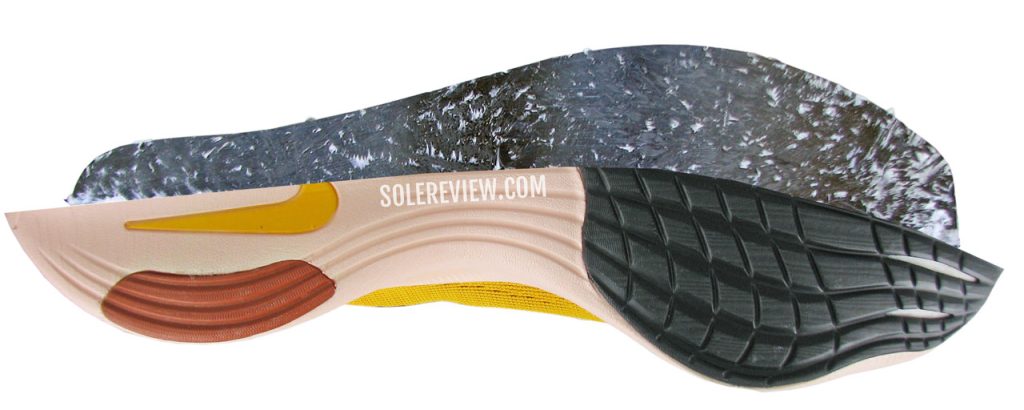
This simulated image gives us a pretty good idea of what the Carbon plate looks like inside the midsole.
If we’re talking about the Nike Vaporfly Next% 2, then it’s a Carbon plate that’s anchored under the forefoot and curves upwards towards the rear, where it’s ‘suspended’ in the soft PEBA midsole.
This placement is similar to the Vaporfly 4% – a shoe that we took apart to show our readers how the plate works. Even though the Next% is an evolution of the 4%, the underlying mechanism hasn’t changed.
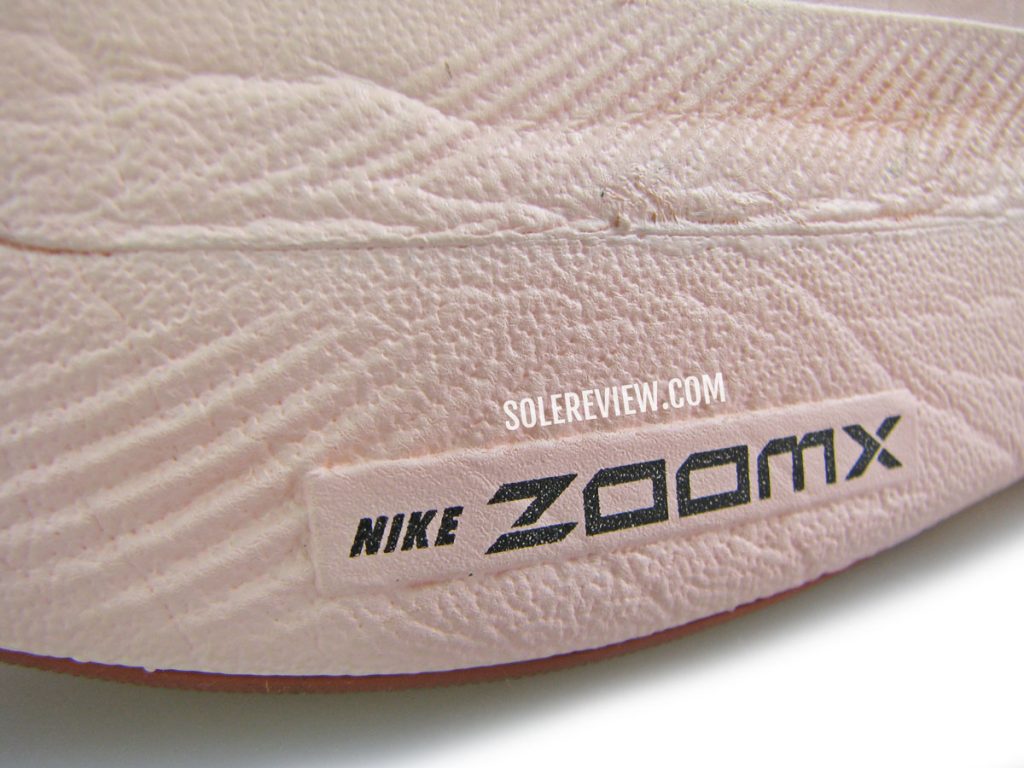
Though the soft and bouncy ZoomX foam gives the Vaporfly its comfortable ride, it’s the Carbon plate that infuses the midsole with the signature snap.
On one hand, the soft and bouncy PEBA foam produces a very comfortable ride. The suspended plate and rigid forefoot do the rest.
The suspended part of the plate acts as a spring under the heel to create a propulsive effect, whereas the rigid forefoot makes roll-offs easier to accomplish.
These characteristics define the Vaporfly, thus making it the ideal shoe for high-mileage efforts. If not for the plate, the Vaporfly Next% 2 would be a very different shoe.
We saw what happens when a midsole is made of nothing but ZoomX foam. You get a ridiculously cushy ride, but without the spring-like road manners. A case in point is the ZoomX Invincible Run, a running shoe that’s uber-cushioned but without the snappy urgency of the Vaporfly.
THE MIDSOLE DESIGN AND RIDE EXPERIENCE
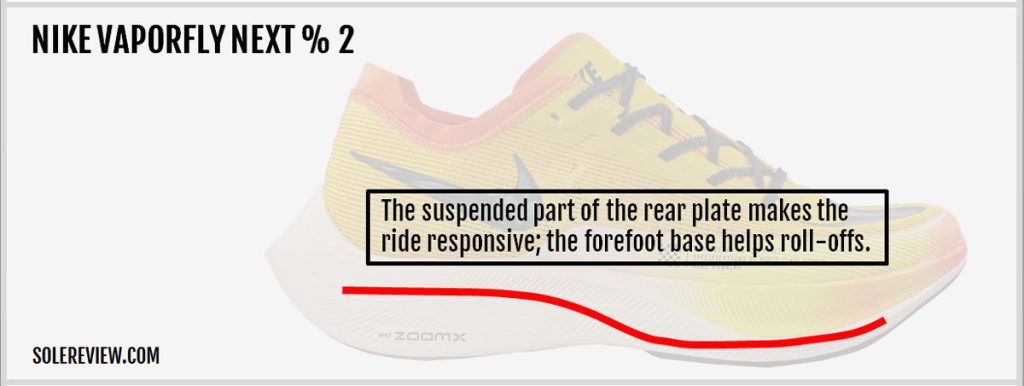
The rear end of the plate is sandwiched between the two foam layers, and delivers the responsive spring-back when loaded.
If somebody were to X-ray the Vaporfly, this is how the Vaporfly Next% 2 would appear. The front of the Carbon plate stays fixed under the forefoot; only the rear end flexes when loaded with weight.
In the Vaporfly’s case, what goes down must come up; and that’s where the magic happens.
When loaded, the soft PEBA foam allows the plate to flex under the heel, thus causing the plate to exert an equal and opposite upwards pressure – or spring potential energy (for our scientifically-minded readers).
This spring-loaded energy is what creates the responsive snap.
As the gait cycle transitions from mid-stance to forefoot loading, the pent-up energy gets released. This creates a noticeable sense of bounciness that shoes such as the Vaporfly and Saucony Endorphin Pro have.
This isn’t to say that all running shoes with a Carbon plate behave alike. There are other shoes with a plate, but lack the snap of the Vaporfly. On this site, we’d cite the Hoka Carbon X and Asics Metaracer as good examples of a non-snappy ride character.
At this point, it’s also worth noting that other Carbon-plate Nike shoes like the Zoom Fly 4 and Alphafly Next% behave differently than the Vaporfly.
For example, the denser React foam midsole of the Zoom Fly 4 mutes the springy snap of the plate, whereas the Zoom Air bag of the Alphafly (and Tempo Next%) dilutes the responsiveness by lowering the angle of the plate. In short, the Vaporfly’s Carbon plate is the snappiest of the three.
The Next% 2 has the same midsole as the V1, so nothing has changed – and that includes the excellent foam-plate integration.
The plate can be sensed working inside the midsole, but there’s no outline felt like on the Vaporfly 4%. The redesigned midsole of the Next% addressed that issue, so the V2 has the same smoothness as the V1.
The second primary ingredient of the Next% – namely the PEBA-based ZoomX foam – adds a high level of ride comfort that’s sufficient for marathon distances. Like all PEBA foams, ZoomX has a high cushioning-to-weight ratio.
There’s no dearth of cushioning softness. Be it the forefoot or heel, the sensation of the bouncy responsiveness is all-pervasive. The only difference between the forefoot and heel cushioning is that the rearfoot gets the added snap from the plate.
The high level of cushioning comfort keeps the feet fresh during marathons and long-distance training. Since the pasted insole isn’t very thick, nearly all of the cushioning is delivered by the midsole.
Most racing shoes have a non-removable insole to prevent them from sliding out of the shoe, so the Vaporfly Next% 2 follows that best practice.
Despite a stack height that’s 8 mm lower (32mm: 40mm) than the heel, the forefoot has a higher volume of ZoomX because of its wider base. The forefoot also gets most of the outsole, as well as the stiffness provided by the plate.
Therefore, there are two ways in which the forefoot behaves differently than the heel.
Firstly, it’s a lot more stable – and the same cannot be said of the slim heel. At slower speeds, the heel lacks lateral and medial support. The midsole sidewalls do not ‘cup’ the foot, as the heel sits above the midsole edge.
Secondly, while the inflexible forefoot lacks the spring-like action of the Carbon plate, it works together with the high toe spring to roll the foot forwards.
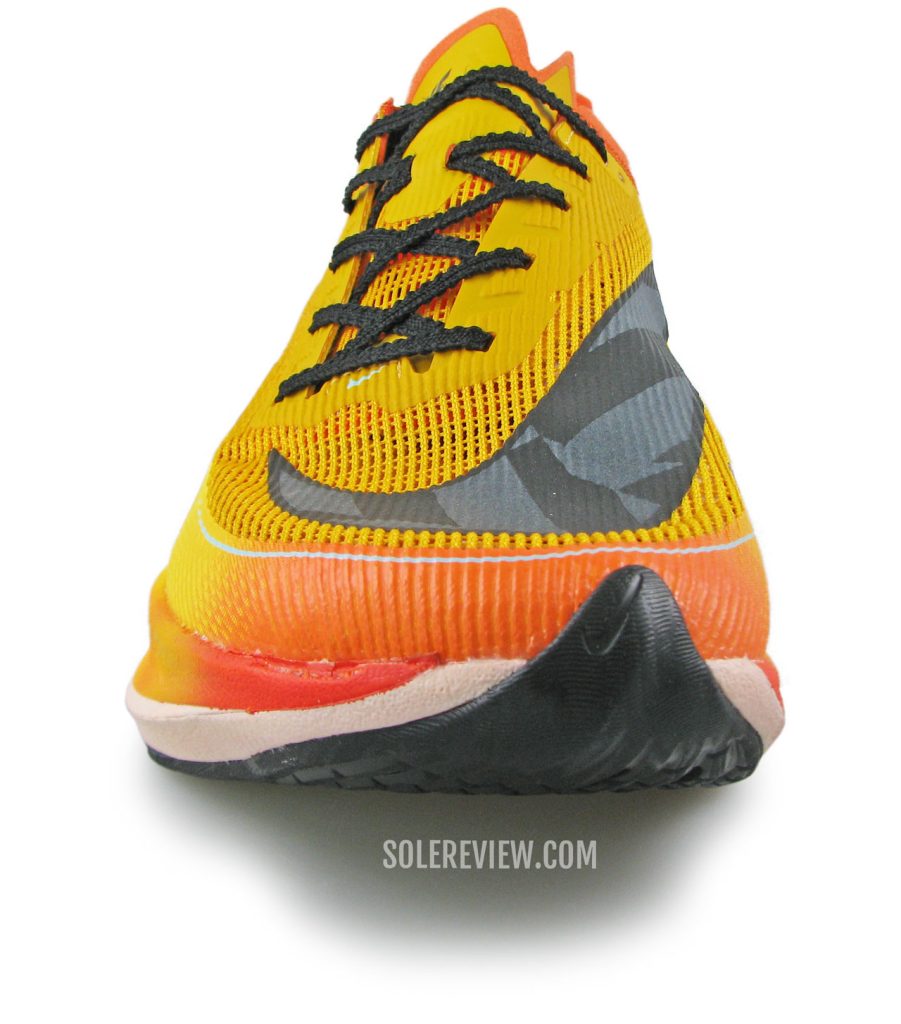
The toe area has a high spring (or ground clearance) to promote roll-offs. The outsole tip looks off-center, but it’s not – the asymmetric lacing and small lip create the optical illusion.
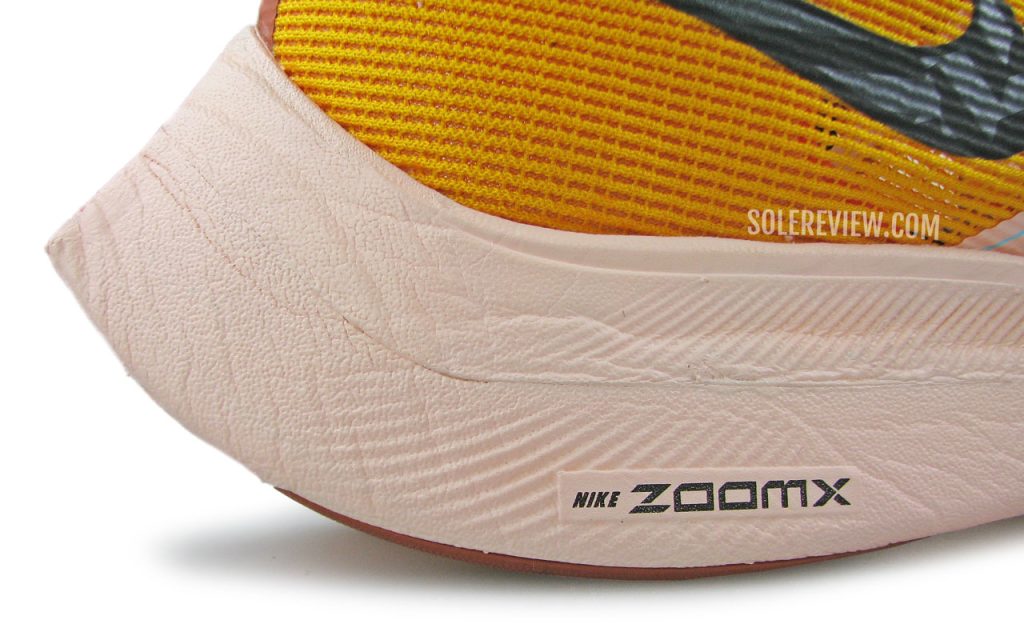
With a slim base and high heel bevel, the midsole makes full-contact or forefoot landings feel natural.
Forefoot (or full-contact) landings feel very natural, and it is the preferred gait pattern for the Vaporfly Next % 2. There’s a lot more outsole real estate under the forefoot than the rear, and the slim heel with its beveled heel doesn’t catch the ground.
Thousands of runners use the Vaporfly Next% 2 as a marathon shoe because of its engaging ride experience that also feels quick. The low weight (6.9-ounces for the median size) means that the shoe disappears on the feet during high-mileage runs.
The question is: how ‘quick’ is the Vaporfly Next% 2? Say, can it keep up with a sub-20 minute 5K pace?
It can, but the Vaporfly is too squishy for setting 5K personal bests – an observation we made about the Vaporfly 4% as well. Sure, even a 5K distance will benefit from the plate-equipped midsole, but for race day, you may want something more efficient.
Of course, this observation doesn’t apply to super-humans like Kipchoge, who runs 2:50 min/km speeds for the entire length of a marathon. Yes, a 2:50 min/km split isn’t a typo – that’s unthinkable for most of us.
On a side note, we have a relevant buyer’s guide for low-profile racing flats.
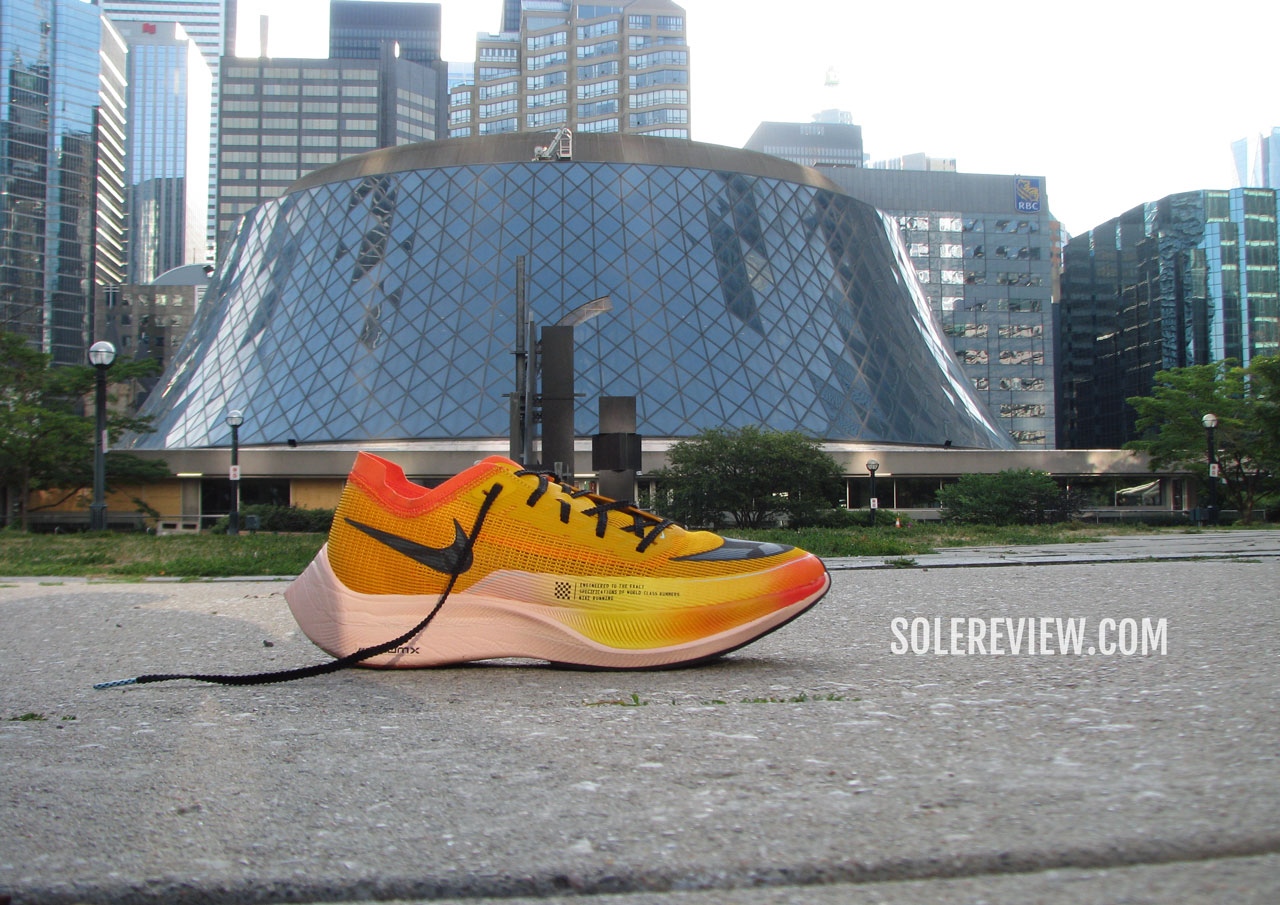
According to Nike, race distances from a 10K to a marathon are the Vaporfly’s sweet spot. We don’t disagree. Maintaining 4:00 min/km isn’t a problem for the Next %, and faster running speeds make the best use of the PEBA foam and plate.
We wished that the outsole traction was better, though. The shallow lug geometry of the soft forefoot rubber outsole doesn’t have the traction of, say, what the adidas adios Pro 2 has.
RECOMMENDED ROTATION
Two Nike running shoes add rotational value to the Next%. The redesigned Nike Pegasus 39 is a great do-it-all trainer for everyday runs, and the ZoomX Streakfly (our review here) could be your lightweight 5K trainer.
As non-Nike options, the Saucony Ride 15 (our review here) and Asics Metaracer (our review here) make an excellent daily trainer and speed shoe pairing.
And if getting the Vaporfly has already depleted your shoe budget, the sub-$100 Asics Hyper Speed (our review here) is also an excellent road racer for shorter distances.
IS THE NIKE VAPORFLY NEXT% 2 DURABLE?
The ZoomX midsole is very prone to creasing, so the sidewalls look beat up after 100 miles. The midfoot and heel sections of the outsole have only a token placement of rubber, so expect visible scuffing to occur.
Despite its seemingly wrinkled appearance, the ZoomX foam is good at retaining its inherent bounciness and cushioning softness.
We’ve yet to come across examples of flattened Vaporfly midsoles.
If we had to put a number to the Vaporfly’s durability, it should last 400 miles with a midfoot striking pattern. Runners who land heel first will get the same mileage, but with a higher extent of scuffing.
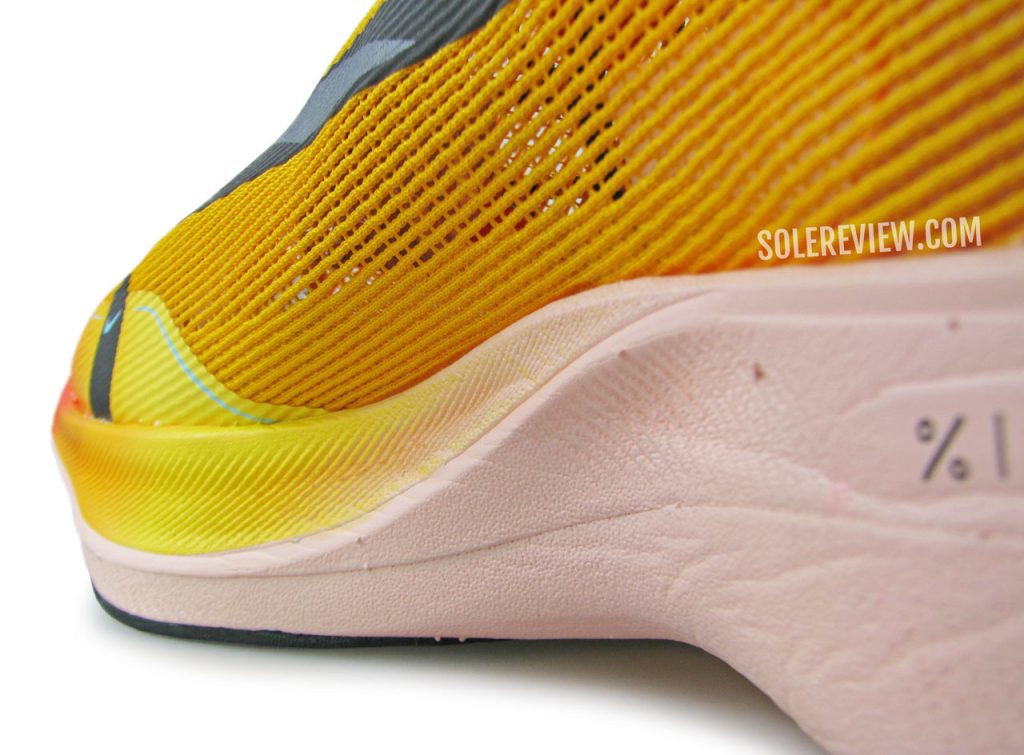
The ZoomX midsole is prone to deep creasing. Note that the mesh section just over the arch has a closely-knit structure for better structural strength.
The breathable mesh exterior has a denser weave (see image above) under the arch, and the toe-bumper is reinforced with a synthetic overlay.
The lacing panel is also backed with a thick underlay to prevent tearing.
THE UPPER DESIGN AND FIT
While the Vaporfly has a level of ride comfort that doesn’t even compare with the traditional racing flats, it does have something in common with old-school racers – its upper fit.
The Vaporfly Next% has a true-to-size fit, but barely.
As befits a racer, the upper is built on a narrow last with a slim waist and form-fitting proportions. The narrow upper securely wraps over the foot without any margin between the foot and mesh.
The toe-box doesn’t have a high ceiling, but it doesn’t feel shallow either. The Next% 2’s toe-box isn’t as shallow as the V1 – the fused toe-bumper is now on the outside, and the change in the mesh also helps.
And that’s a good thing, as it keeps the foot locked in over the midsole. A snug fit also helps build a better connection with the ground, and that’s good for quicker transitions – which is exactly what this shoe is supposed to deliver.
The snugness is distributed evenly throughout the upper, so the narrowness isn’t localized.
The asymmetrically-skewed lacing keeps the top-down pressure low, and serrated laces stayed tied during fast runs.
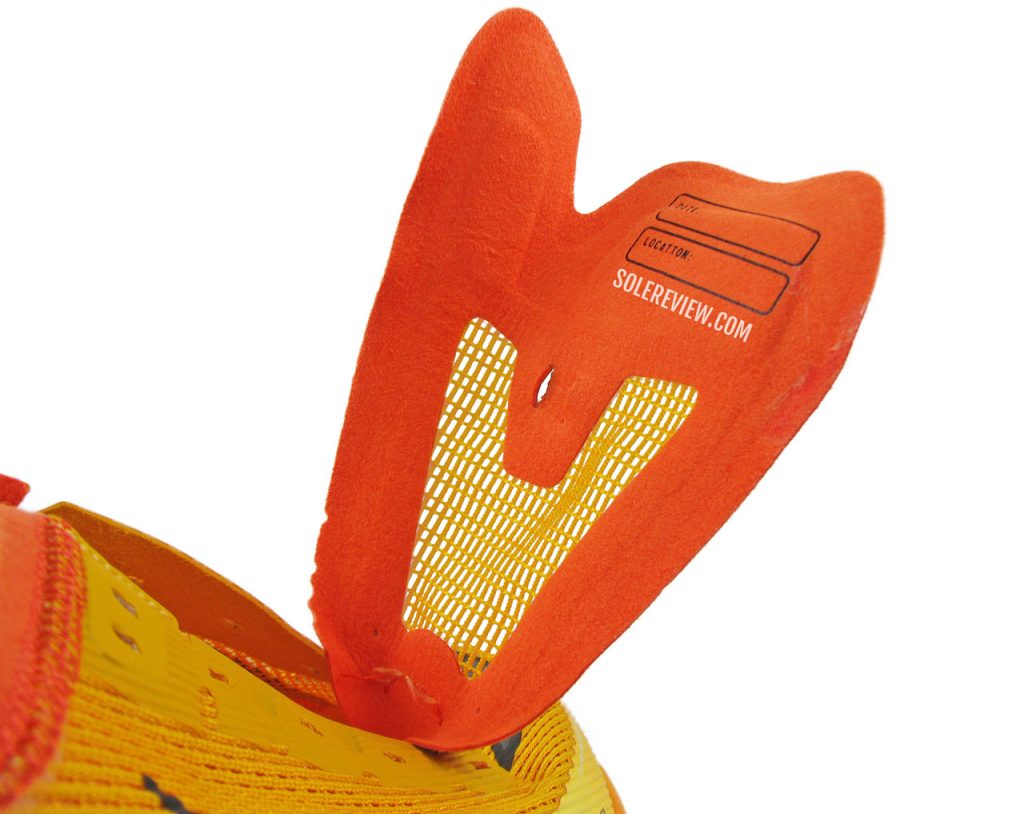
The deep V-notch of the tongue helps it sit flush over the foot. The wide flap and asymmetrical lacing prevent tongue slide.
The V-notch on the tongue flap helps it sit flush over the instep, and doesn’t pucker during dorsiflexion – a state where the foot is pointing upwards during landing.
There’s no sleeve inside the shoe, and yet there’s barely any tongue slide; the asymmetrical design and wide flap minimize the tongue movement.
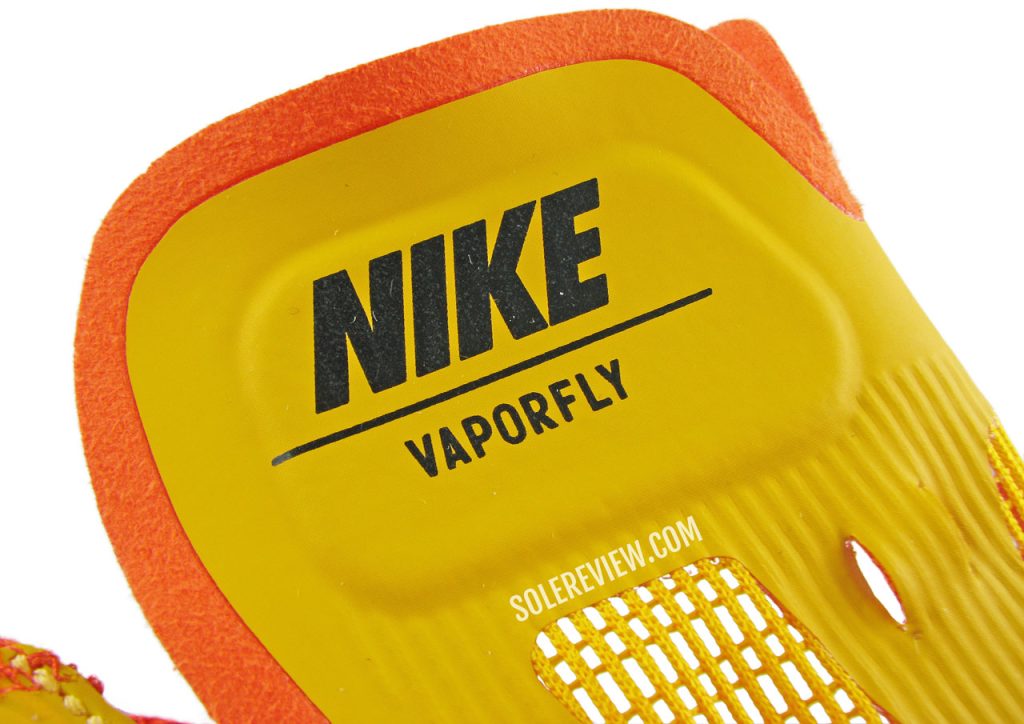
The upper part of the flap has foam-filled pockets to filter the lacing pressure. The lining (in orange) is soft synthetic suede.
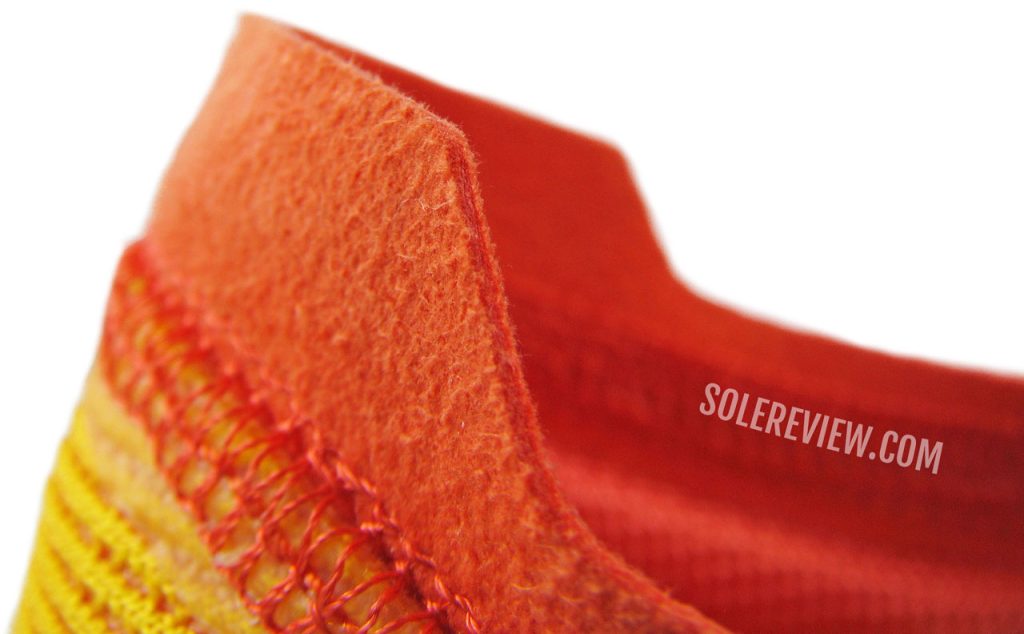
There’s not much use for the collar edges, as they don’t come in contact with the foot. The foam pods create a gap near the top. However, that’s not detrimental to the quality of fit.
Even though the upper lacks unnecessary trims, interior comfort isn’t lacking. The tongue flap has padded pockets and uses soft synthetic as a lining – as do the heel collar edges.
Nearly all of the heel grip is delivered by the foam pods inside the collar, so don’t be concerned by the visible gap on top. The heel has a stiff internal counter to support the foot.
We prefer the Next% 2’s breathable mesh over the V1’s plasticky ‘Vaporweave’. The new mesh is like a sieve; large vents make the upper almost see-thru.
The ventilated interior is perfect for the warmer months and keeping the feet cool during high-mileage runs.
In the sports marketing industry, the extra-large Nike logo on the shoe is called a ‘television logo’. It’s called so because the oversized branding is visible on television screens – a non-negotiable when sponsored athletes are winning races wearing the shoe.
Within Nike, these forward logos were first seen on football (soccer) boots – the most famous of which was another shoe with the name ‘Vapor’ in it. Some previous editions of the Mercurial Vapor (2007-2010) had a mega-logo that resembled the kind on the Vaporfly.
And by the way, if you were wondering what ‘Ekiden’ means, it’s a Japanese long-distance relay race. It’s a two-day race that consists of five legs (or relays) on each day, with each leg being approximately a half-marathon length.
The bright color scheme also draws inspiration from the rising and setting sun, and the logos on the tongue are inspired by the Hakone Ekiden.
PROS AND CONS
If it weren’t for the Nike Vaporfly Next% 2’s stand-out qualities, it wouldn’t have amassed such a legion of loyalists.
The PEBA midsole (aka ZoomX) offers an unprecedented cushioning-to-weight ratio, along with a ride character that favors high speeds. The soft and responsive midsole minimizes fatigue, whereas the Carbon plate and inflexible forefoot make quick transitions happen.
The narrow upper fits like a glove, and has excellent ventilation. There are no widths available, so wide-footed runners may have to consider alternatives. There’s a generous amount of reflectivity available on the upper to make running in low light conditions safer.
The heel stability has never been the forte of Carbon-plated racers like the Vaporfly and Saucony Endorphin Pro.
The slim heel made of the soft ZoomX foam isn’t very supportive, so we don’t recommend walking or slow-speed running that involves a lot of heel-first contact.
COMPARISON: THE NIKE VAPORFLY NEXT% V2 VERSUS ZOOM FLY 4 AND ALPHAFLY NEXT%
There are three Nike running shoes with a Carbon plate, but we like the Vaporfly Next% 2 the best.
At the top of the price-pyramid is the Alphafly Next% – a Carbon plated shoe with a high-volume PEBA midsole and Zoom Air bag.
In our review, we explained that while the Alphafly has better heel stability than the Vaporfly because of the wider midsole, the plate isn’t as snappy as the Vaporfly.
That’s because the Zoom Air bag lowers the angle of the Carbon plate, thus reducing its ability to spring-load.
The Nike Zoom Fly 4 is a versatile shoe that, unlike the Alphafly or Vaporfly, doesn’t use the soft ZoomX foam.
Its React foam midsole makes it a much heavier shoe (9.6-ounces) with a firmer ride.
The Carbon plate experience is a lot more muted because of the denser midsole, but in return, the Zoom Fly 4 offers a higher level of stability and durability. Read all about the Zoom Fly 4 in our in-depth review.
SHOES SIMILAR TO THE NIKE VAPORFLY NEXT% 2
Besides the Zoom Fly 4 and Alphafly, here are some similar alternatives to the Next% 2.
With its PEBA midsole and similarly-shaped Carbon plate, the Saucony Endorphin Pro 2 is the closest match to the Vaporfly Next%. The ride is soft and bouncy, and the Carbon plate performs as expected – which is to create a spring-like sensation during the gait cycle.
However, the Saucony Endorphin Pro 2 is $50 less expensive and has a more comfortable upper with a softer feel. The soft tongue, sleeve, and heel collar have a plush hand feel; the lacing also isn’t skewed asymmetrically. There’s more outsole rubber under the midsole, so the extent of midsole scuffing is going to be lower.
On the flip side, the Endorphin Pro 2 has lower heel stability than the Vaporfly. The Endorphin Speed 2 fares slightly better due to its fabric lasting and Nylon plate (instead of Carbon), and it’s also a much cheaper alternative to both the Endorphin Pro and Vaporfly Next%.
The New Balance RC Elite V2 uses a soft Fuelcell foam midsole and a Carbon plate in a similar curved geometry as the Vaporfly.
The same goes for the Asics Metaspeed Sky – a Carbon plated racer with a soft Flytefoam Turbo midsole – a foam that feels halfway between Nike’s ZoomX and New Balance Fuelcell.
There are a couple of other plated racers with a firmer ride.
The Brooks Hyperion Elite 3 is a lightweight cushioned racer with a plate, except that Nitrogen-infused ‘DNA Flash’ foam produces a firmer ride. The adidas adios Pro 2 doesn’t have a plate at all, but a set of tubular ‘Energy rods’ that help make the roll-offs more efficient.
Do you own this shoe? Improve this review by sharing your insights – submit a review here.

